HARRIS M7200 M7200 700/800 MHz Mobile Radio User Manual TYPE CERTIFICATION REPORT
Harris Corporation M7200 700/800 MHz Mobile Radio TYPE CERTIFICATION REPORT
HARRIS >
Contents
Manual 1

Rhein Tech Laboratories Client: M/A COM, Inc.
360 Herndon Parkway Model: CS-7200 OpenSky Control Station
Suite 1400 FCC ID: BV8M7200/3670A-M7200
Herndon, VA 20170 Standards: Part 90/RSS-119
http://www.rheintech.com Report #: 2007152
21 of 30
Appendix F: User Manual
Please refer to the following pages.
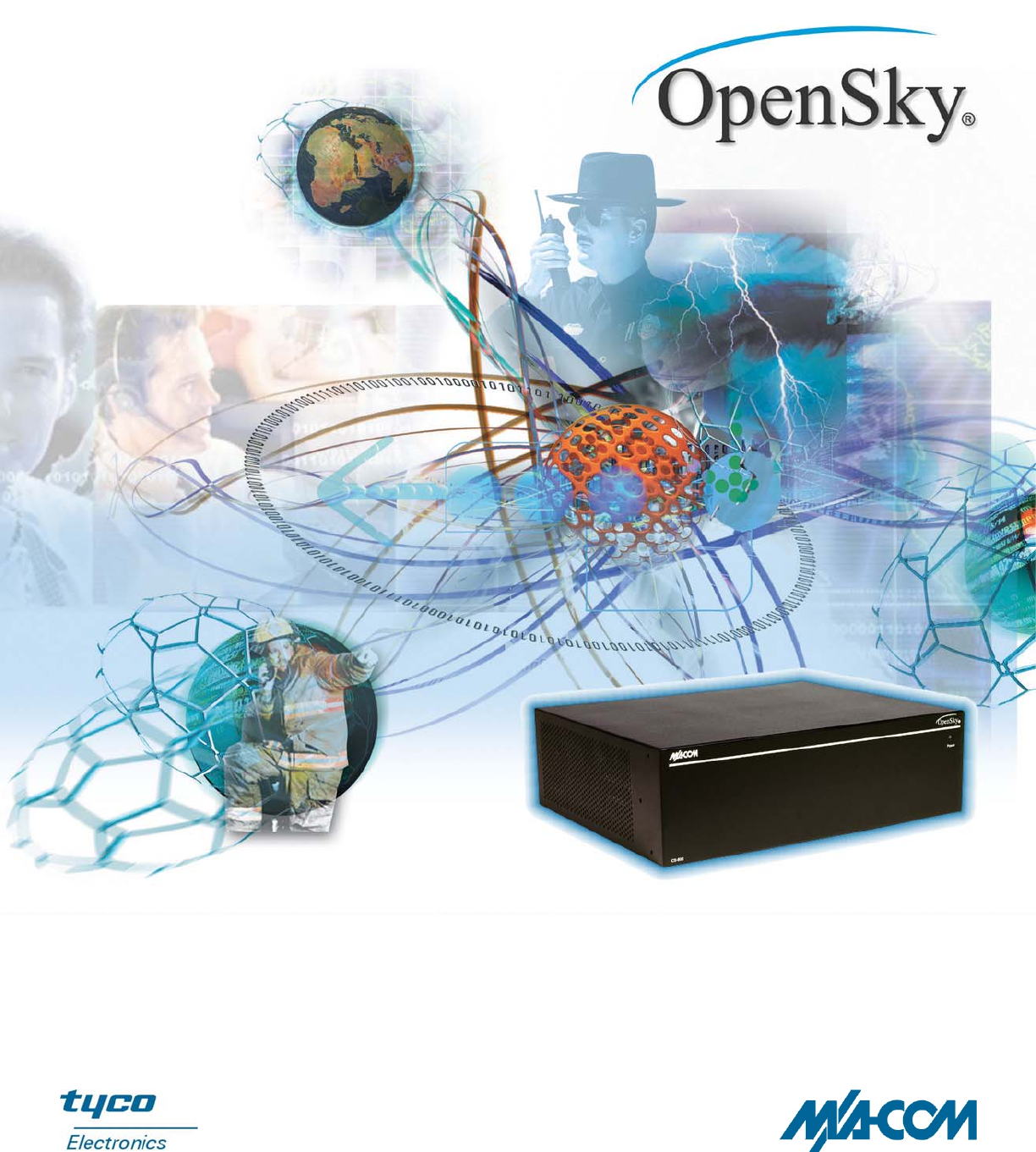
Operator’s Manual
MM-011709-001
Feb/07
CS-7200 with SP-103
Control Station with Deskset

MM-011709-001
2
MANUAL REVISION HISTORY
REV DATE REASON FOR REVISION
Rev. - Feb/07 Initial Release.
M/A-COM Technical Publications would particularly appreciate feedback on any errors found in this document and
suggestions on how the document could be improved. Submit your comments and suggestions to:
Wireless Systems Business Unit or fax your comments to: (434) 455-6851
M/A-COM, Inc.
Technical Publications or e-mail us at: techpubs@tycoelectronics.com
221 Jefferson Ridge Parkway
Lynchburg, VA 24501
CREDITS
This device is made under license under one or more of the following US patents: 4,590,473; 4,636,791; 5,148,482;
5,185,796; 5,271,017; 5,377,229; 4,716,407; 4,972,460; 5,502,767; 5,146,497; 5,164,986; 5,185,795.
The voice coding technology embodied in this product is protected by intellectual property rights including patent rights,
copyrights, and trade secrets of Digital Voice Systems, Inc. The user of this technology is explicitly prohibited from
attempting to decompile, reverse engineer, or disassemble the Object Code, or in any other way convert the Object Code into
human-readable form.
OpenSky is a registered trademark of M/A-COM, Inc.
All other brand and product names are trademarks, registered trademarks or service marks of their respective holders.
This product conforms to the European Union WEEE Directive 2002/96/EC. Do not dispose of this product in a
public landfill. Take it to a recycling center at the end of its life.
NOTICE!
This manual covers M/A-COM products manufactured and sold by M/A-COM, Inc.
Repairs to this equipment should be made only by an authorized service technician or facility designated by the supplier. Any
repairs, alterations or substitutions of recommended parts made by the user to this equipment not approved by the
manufacturer could void the user's authority to operate the equipment in addition to the manufacturer's warranty.
This manual is published by M/A-COM, Inc., without any warranty. Improvements and changes to this manual necessitated
by typographical errors, inaccuracies of current information, or improvements to programs and/or equipment, may be made
by M/A-COM, Inc., at any time and without notice. Such changes will be incorporated into new editions of this manual. No
part of this manual may be reproduced or transmitted in any form or by any means, electronic or mechanical, including
photocopying and recording, for any purpose, without the express written permission of M/A-COM, Inc.
Copyright© 2007 M/A-COM, Inc. All rights reserved.

MM-011709-001
3
TABLE OF CONTENTS Page
1 SAFETY INFORMATION ......................................................................................................................... 6
1.1 IMPORTANT SAFETY INSTRUCTIONS............................................................................................ 6
1.2 FCC REGULATIONS............................................................................................................................. 7
1.2.1 Antennas.................................................................................................................................... 7
2 PRODUCT DESCRIPTION ....................................................................................................................... 8
2.1 CS-7200 CONTROL STATION............................................................................................................. 8
2.2 MODES OF OPERATION...................................................................................................................... 8
2.2.1 VOICE OPERATION...............................................................................................................8
2.2.2 DATA OPERATION ................................................................................................................ 9
2.2.3 INTERCOM OPERATION ......................................................................................................9
2.3 SP-103 DESKSET...................................................................................................................................9
2.4 TRCM-103 TONE REMOTE CONTROL MODULE.......................................................................... 10
2.5 PERSONALITY.................................................................................................................................... 10
2.5.1 Profiles .................................................................................................................................... 10
2.5.2 Talk Groups............................................................................................................................. 11
3 CS-7200/SP-103 OPERATION ................................................................................................................. 12
3.1 CONTROLS AND INDICATORS ....................................................................................................... 12
3.1.1 CS-7200 Front Panel ............................................................................................................... 12
3.1.2 CS-7200 Rear Panel ................................................................................................................ 12
3.1.3 SP-103 Front Panel.................................................................................................................. 13
3.1.4 SP-103 Rear Panel................................................................................................................... 13
3.2 DISPLAY OVERVIEW........................................................................................................................ 15
3.2.1 Network Connectivity Icon ..................................................................................................... 15
3.2.2 Volume Level Icon.................................................................................................................. 15
3.2.3 Display’s Top Line.................................................................................................................. 15
3.2.4 Display’s Bottom Line ............................................................................................................ 15
3.2.5 Dwell Display.......................................................................................................................... 18
3.2.6 Menu Display and Control Area..............................................................................................18
3.2.7 Dwell Display User-Selectable................................................................................................19
3.3 BASIC RADIO OPERATION .............................................................................................................. 19
3.3.1 POWER UP............................................................................................................................. 19
3.3.2 Self-Test .................................................................................................................................. 20
3.3.3 Logging In to the Network......................................................................................................20
3.3.4 Logging off the Network.........................................................................................................20
3.3.5 POWER DOWN......................................................................................................................20
3.3.6 Receiving and Transmitting Voice Calls................................................................................. 20
3.3.7 Tones....................................................................................................................................... 21
3.3.8 Adjusting Side Tone Audio Level........................................................................................... 22
3.3.9 Adjusting Display & Button Backlight Brightness ................................................................. 23
3.3.10 Adjusting Speaker/Headset Audio Treble Level..................................................................... 23
3.3.11 Checking or Changing the Active Profile ............................................................................... 23
3.3.12 Checking or Changing the Selected Talk Group..................................................................... 24
3.4 INTERCOM MODE.............................................................................................................................. 25
3.5 TALK GROUP LOCK OUT................................................................................................................. 25
3.5.1 Locking Out a Talk Group ...................................................................................................... 26
3.5.2 Unlocking a Talk Group..........................................................................................................26
3.6 SCAN MODE........................................................................................................................................ 27
3.6.1 Checking or Changing Active Scan Mode.............................................................................. 28

MM-011709-001
4
TABLE OF CONTENTS Page
3.6.2 Scanning Priority.....................................................................................................................28
3.7 SELECTIVE CALL............................................................................................................................... 29
3.7.1 Making a Selective Call ..........................................................................................................29
3.7.2 Receiving a Selective Call.......................................................................................................30
3.8 SELECTIVE ALERT ............................................................................................................................30
3.8.1 Sending Selective Alert Messages...........................................................................................30
3.8.2 Receiving Selective Alert Messages .......................................................................................31
3.8.3 Defining Pre-Programmed Messages...................................................................................... 32
3.9 TELEPHONE INTERCONNECT CALLS...........................................................................................32
3.10 EMERGENCY COMMUNICATIONS..................................................................................32
3.10.1 Declaring an Emergency Call or Alert....................................................................................33
3.10.2 Clearing an Emergency Call or Alert...................................................................................... 33
3.10.3 Silent Emergency ....................................................................................................................34
3.10.4 Receiving an Emergency Call .................................................................................................34
3.10.5 Dismissing an Emergency Call ...............................................................................................34
3.11 DUAL-TONE MULTI-FREQUENCY KEYPAD.................................................................. 35
3.11.1 Password Entry........................................................................................................................35
3.11.2 Overdial...................................................................................................................................35
3.12 ENCRYPTION........................................................................................................................ 35
3.12.1 Automatic Encryption .............................................................................................................36
3.12.2 Manual Encryption..................................................................................................................36
3.13 PRESET BUTTONS............................................................................................................... 37
3.14 DYNAMIC REGROUPING ...................................................................................................37
3.15 ENGINEERING DISPLAY....................................................................................................38
3.15.1 Voice and Data Registration Codes......................................................................................... 38
3.15.2 Transceiver Status ................................................................................................................... 38
3.15.3 Receive Signal Strength Indication (RSSI)............................................................................. 39
3.15.4 Control Block Symbol Error Rate (CBSER)...........................................................................39
4 CS-7200/TRCM-103 OPERATION.......................................................................................................... 40
4.1 POWER UP ........................................................................................................................................... 40
4.2 NETWORK LOG ON ...........................................................................................................................40
4.3 SELF-TEST...........................................................................................................................................40
4.4 CONTROLS AND INDICATORS .......................................................................................................40
4.5 VOICE CALLS .....................................................................................................................................40
4.5.1 Receiving a Voice Call............................................................................................................40
4.5.2 How to Make a Voice Call...................................................................................................... 40
4.6 RADIO TONES.....................................................................................................................................41
4.7 POWER DOWN.................................................................................................................................... 41
5 BASIC TROUBLESHOOTING ............................................................................................................... 42
6 WARRANTY.............................................................................................................................................. 43

MM-011709-001
5
TABLE OF CONTENTS Page
FIGURES
Figure 2-1: CS-7200 ......................................................................................................................................... 8
Figure 2-2: SP-103 Deskset.............................................................................................................................. 9
Figure 2-3: Personality Structure Example..................................................................................................... 10
Figure 3-1: CS-7200 Front Panel.................................................................................................................... 12
Figure 3-2: CS-7200 Rear Panel..................................................................................................................... 12
Figure 3-3: SP-103 Front Panel ...................................................................................................................... 13
Figure 3-4: SP-103 Rear Panel ....................................................................................................................... 13
Figure 3-5: Sample Display (Talk Group Menu Session)............................................................................... 15
Figure 3-6: Top and Bottom Display Lines.................................................................................................... 18
Figure 3-7: Dwell Display and Speaker Volume Icon.................................................................................... 19
Figure 3-8: Side Tones Menu ......................................................................................................................... 23
Figure 3-9: Profile Menu ................................................................................................................................ 24
Figure 3-10: Talk Group Menu....................................................................................................................... 25
Figure 3-11: Lock Out Menu.......................................................................................................................... 27
Figure 3-12: Example Engineering Display ................................................................................................... 38
TABLES
Table 3-1: SP-103 Front Panel Controls and Functions ................................................................................. 14
Table 3-2: SP-103 Rear Panel Connections and Functions ............................................................................ 14
Table 3-3: Basic Menu Structure.................................................................................................................... 16
Table 3-4: Display Parts and Functions.......................................................................................................... 18
Table 3-5: Alert Tones.................................................................................................................................... 21
Table 3-6: Scan Modes ................................................................................................................................... 28
Table 3-7: Possible Status of Selective Alert.................................................................................................. 31
Table 3-8: Voice Registration Codes.............................................................................................................. 38
Table 3-9: Data Registration Codes................................................................................................................ 39
Table 5-1: Basic Troubleshooting................................................................................................................... 42
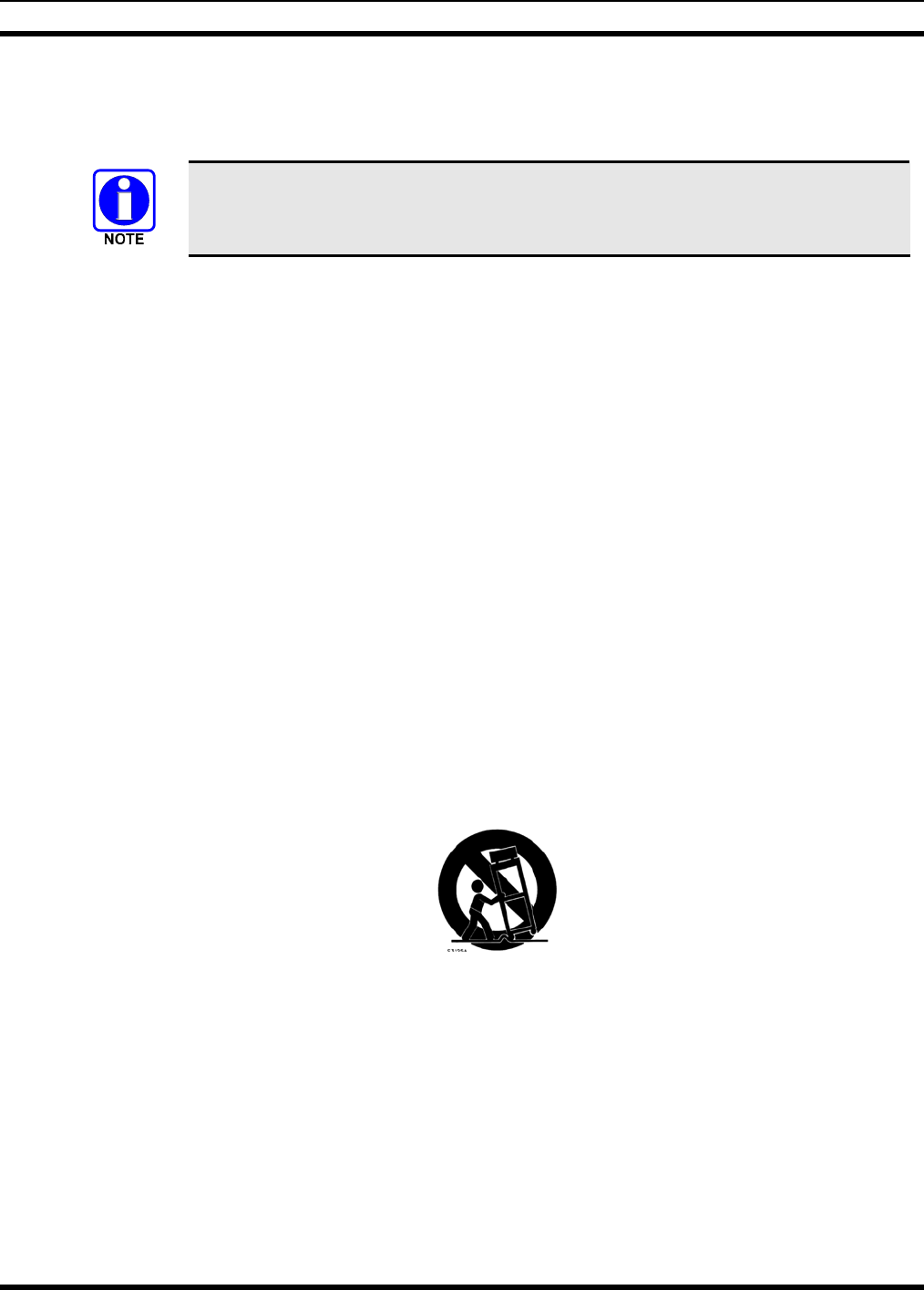
MM-011709-001
6
1 SAFETY INFORMATION
1.1 IMPORTANT SAFETY INSTRUCTIONS
The user is responsible at all times for the proper operation and maintenance of the
equipment.
1. Read these instructions.
2. Keep these instructions.
3. Heed all warnings.
4. Follow all instructions.
5. Do not use this apparatus near water.
6. Clean only with dry cloth.
7. Do not block any ventilation openings. Install in accordance with the manufacturer’s instructions.
8. Do not install near any heat sources such as radiators, heat registers, stoves, or other apparatus
(including amplifiers) that produce heat.
9. Do not defeat the safety purpose of the polarized or grounding-type plug. A polarized plug has two
blades with one wider than the other. A grounding type plug has two blades and a third grounding
prong. The wide blade or the third prong is provided for your safety. If the provided plug does not fit
into your outlet, consult an electrician for replacement of the obsolete outlet.
10. Protect the power cord from being walked on or pinched particularly at plugs, convenience
receptacles, and the point where they exit from the apparatus.
11. Only use attachments/accessories specified by the manufacturer.
12. Use only with the cart, stand, tripod, bracket, or table specified by the manufacturer, or sold with the
apparatus. When a cart is used, use caution when moving the cart/apparatus combination to avoid
injury from tip-over.
13. Unplug this apparatus during lightning storms or when unused for long periods of time.
14. Refer all servicing to qualified service personnel. Servicing is required when the apparatus has been
damaged in any way, such as power-supply cord or plug is damaged, liquid has been spilled or
objects have fallen into the apparatus, the apparatus has been exposed to rain or moisture, does not
operate normally, or has been dropped.
15. Warning: The lightning bolt signifies an alert to the user of the presence of un-insulated “dangerous
voltage” within the product’s enclosure that may be of significant magnitude to constitute a risk of
electric shock to persons.

MM-011709-001
7
16. Warning: The exclamation point alerts the user to the presence of important operation and
maintenance (service) instructions in the literature accompanying the product.
17. Outdoor Use Warning: To reduce the risk of Fire or Electric Shock, Do Not Expose This Apparatus to
Rain or Moisture.
18. Wet Location Warning: Apparatus shall not be exposed to dripping or splashing and no objects filled
with liquids, such as vases, shall be placed on the apparatus.
1.2 FCC REGULATIONS
Use, installation and service of this equipment as summarized within this Manual will ensure the safe
performance of this equipment and will result in user exposure substantially below FCC recommended
limits for human exposure to Radio Frequency electromagnetic energy.
These devices comply with Part 15 of the FCC Rules. Operation is subject to the following two
conditions: (1) the device may not cause harmful interference; and (2) the device must accept any
interference received, including interference that may cause undesired operation.
These devices are not required to comply with the FCC RF exposure limits for Uncontrolled Exposure
(General Population) and Occupational Exposure, because it is assumed that neither uncontrolled nor
occupational exposure is applicable in the general installation configuration. The CS-7200 must be
disabled before maintenance to the antenna is attempted.
The Federal Communications Commission (FCC) requires the user to obtain a station license for this
radio equipment before operation.
FCC regulations state that the frequency, deviation, and power of the radio transmitter must be
maintained within specific limits. It is recommended, therefore, that these three parameters be checked
prior to placing the station in service.
1.2.1 Antennas
The CS-7200 and antenna must be professionally installed by an experienced antenna installation
professional. During the installation of directional antennas, the installer must not point the main beam of
the antenna at locations occupied by persons within the distance of maximum permissible exposure limits
specified in Part 2 of the FCC regulations. Failure to follow these instructions will void the product
warranty and may expose the end user and others to excessive Radio Frequency hazard. All antennas are
intended to be installed outdoors and at distances from personnel well beyond the minimum allowable
distance.
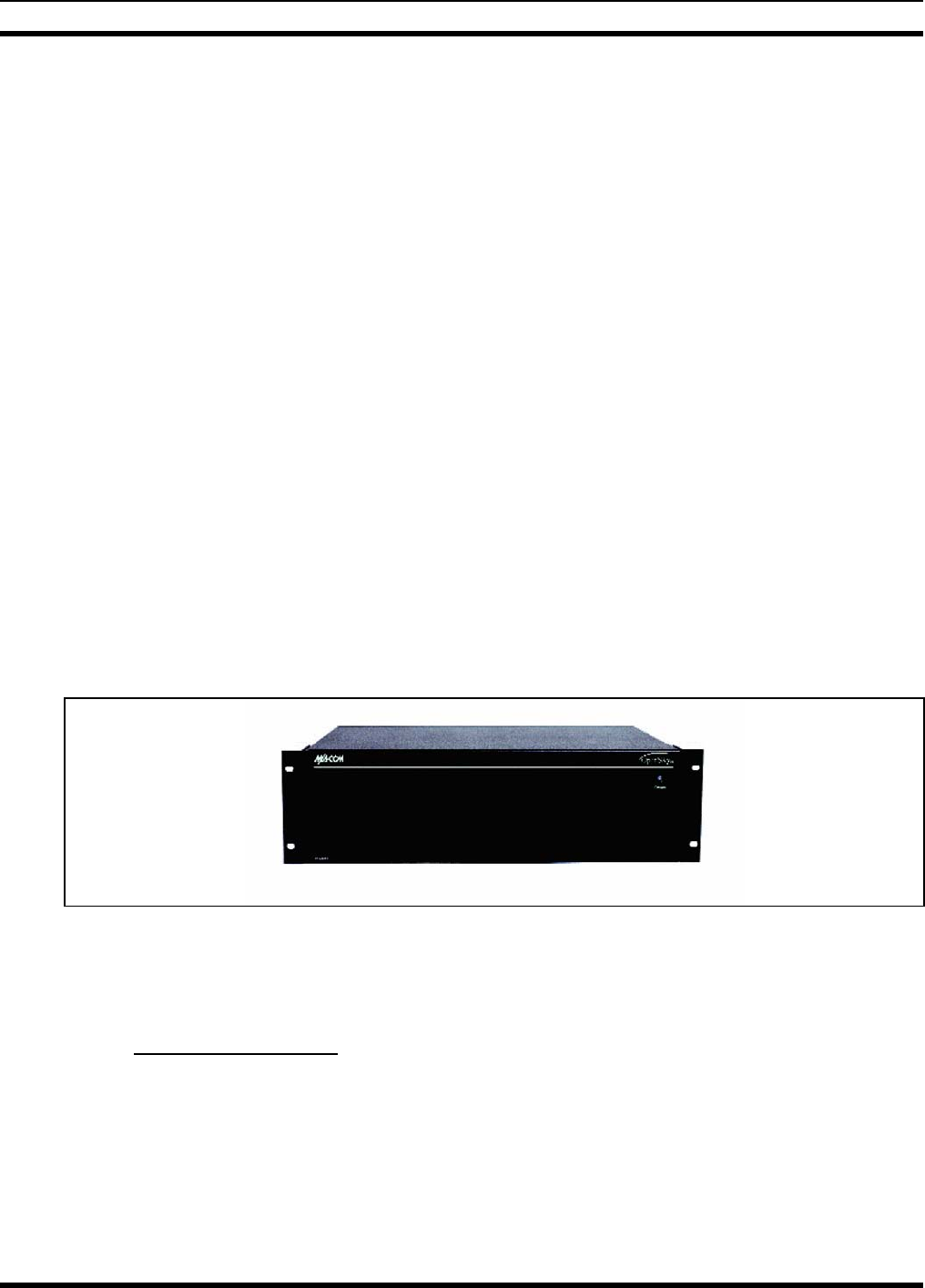
MM-011709-001
8
2 PRODUCT DESCRIPTION
2.1 CS-7200 CONTROL STATION
The CS-7200 Control Station is a component of the OpenSky® network, an integrated voice and data
communications system that delivers end-to-end digital transmissions over a single wireless network to
various subscriber units.
The CS-7200 is used typically for dispatch purposes and operates over both the Specialized Mobile Radio
(SMR) and National Public Safety Planning Advisory Committee (NPSPAC) frequency bands. These
bands provide a total of over 830 possible channels spread over the 806-824 MHz transmission and 851-
869 MHz reception bands. The CS-7200 operates half-duplex voice, full duplex data, with a 15 W
(typical) transmit output power.
The CS-7200 uses Time Division Multiple Access (TDMA) technology to allow multiple users to share a
single RF channel. In addition, a single 20 kHz RF channel can support simultaneous digital voice and
data communications. The radio supports the OpenSky Trunked Protocol (OTP).
The CS-7200 provides voice and data services in a dispatch operation. Voice operation is provided using
the SP-103 Deskset or third-party Tone Remote Desk Sets via the TRCM-103. For data transfers, the CS-
7200 and the SP-103 are equipped with an industry standard TIA/EIA-232 interface serial port for
connecting optional equipment such as a laptop PC or third-party display or key-entry device. OpenSky
works seamlessly with equipment from popular manufacturers and off-the-shelf applications through a
standard UDP/IP Protocol, providing simple “plug and play” connectivity.
The CS-7200 is a “soft” radio. Its functions are determined by whatever release of OpenSky software
applications are installed. Refer to Figure 2-1 for a picture of the CS-7200.
Figure 2-1: CS-7200
2.2 MODES OF OPERATION
2.2.1 VOICE OPERATION
The voice path operates like a traditional dispatch radio, with a microphone to transmit (push-to-talk) and
a speaker to receive. In OpenSky Trunked Protocol (OTP), there is no separate voice and data path – all
transmitted information is digital.
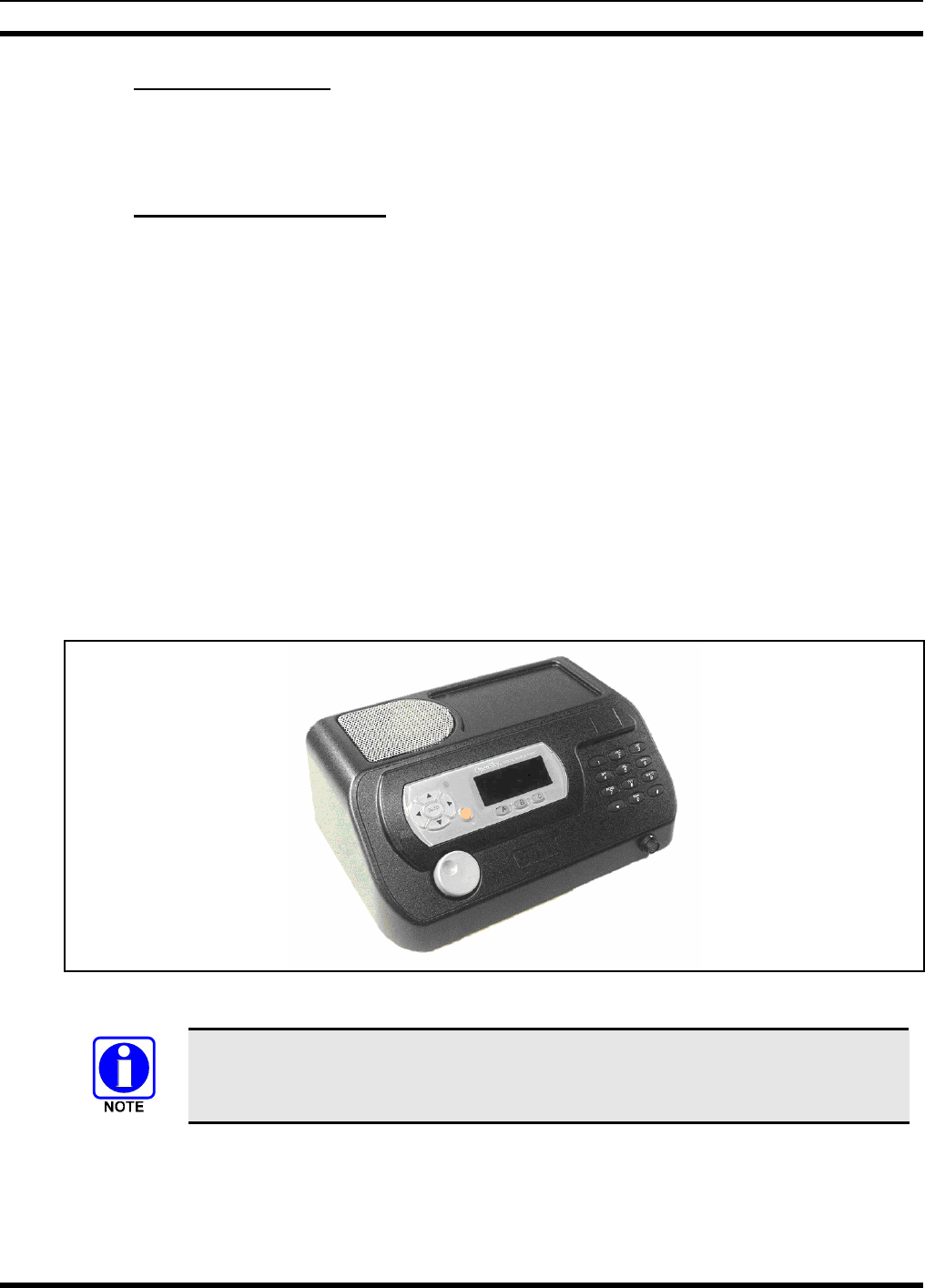
MM-011709-001
9
2.2.2 DATA OPERATION
Data operation requires the connection of a laptop PC. OpenSky works through standard IP protocols
such as UDP/IP. The data path operates similarly to the voice path, with a few differences. All external
data information in and out of the radio uses the TIA/EIA-232 serial port connection.
2.2.3 INTERCOM OPERATION
The intercom option, a licensed option, allows the CS-7200 radio to pass audio locally between multiple
SP-103 units, not over the network. It gives users at multiple SP-103 units, connected to the same CS-
7200, the ability to communicate with each other without transmitting over-the-air. When activated,
incoming network radio calls are still scanned and broadcast at each SP-103 units.
2.3 SP-103 DESKSET
The SP-103 Deskset is part of the OpenSky suite of radio products delivering high capacity, end-to-end,
digital communication and providing remote access for voice, data, and control of the CS-7200 Control
Station.
The SP-103 supports voice access via PTT microphones or headset microphones/speaker devices. The
SP-103 also provides an interface for a footswitch PTT in order to support microphones/headsets that do
not contain integral PTT switches. The SP-103 has an integral 3x4 DTMF keypad for log-on and selective
calling. The SP-103 contains an integral 10-Watt speaker and provides the interface to connect to an
external 10-Watt speaker. The serial port can be used for data operation. Refer to Figure 2-2 for a picture
of the SP-103.
Figure 2-2: SP-103 Deskset
Refer to Installation Manual MM-011712-001 when configuring the SP-103.
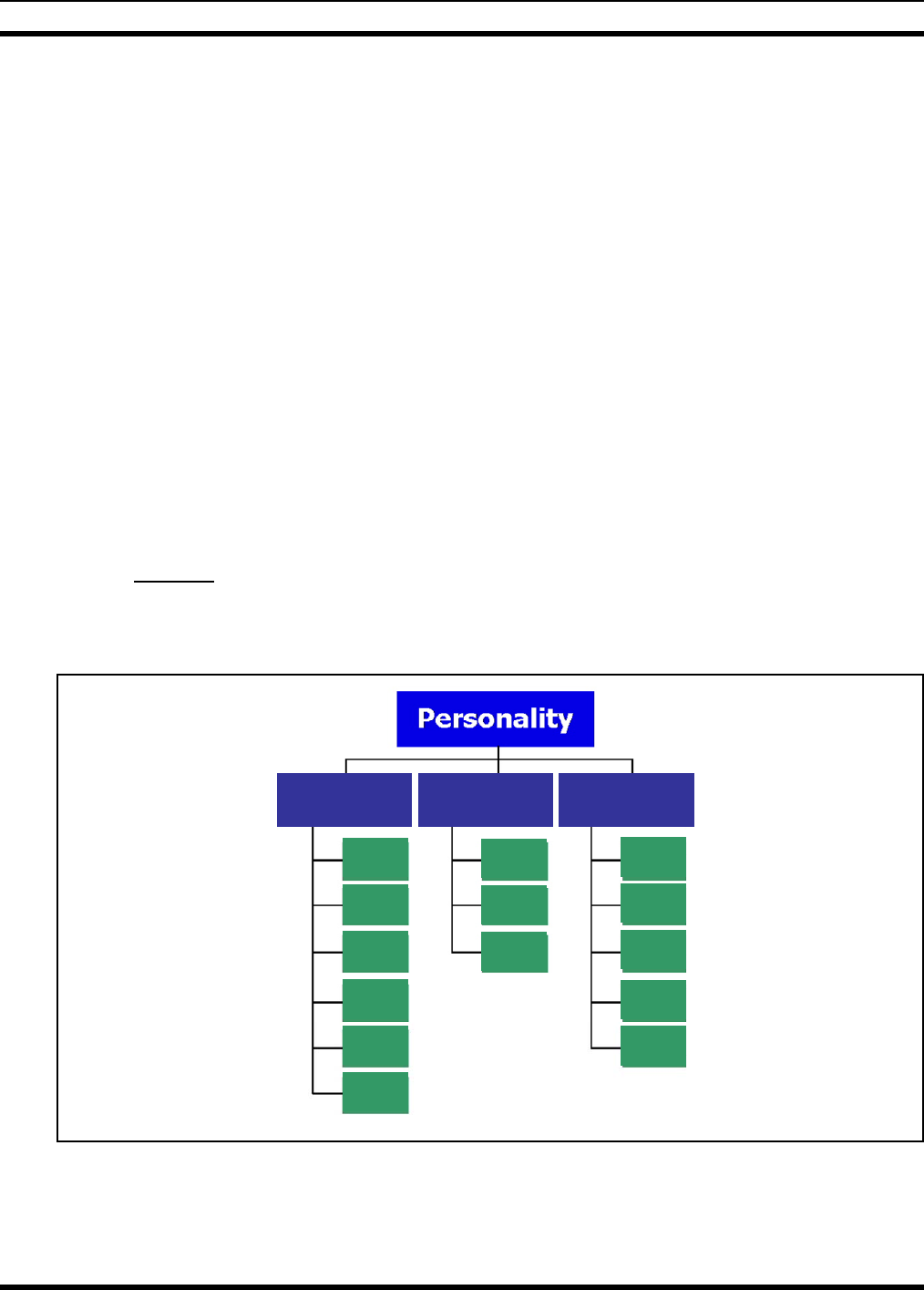
MM-011709-001
10
2.4 TRCM-103 TONE REMOTE CONTROL MODULE
The TRCM-103 operates within the OpenSky network as part of a Dispatch Center in conjunction with a
third-party Tone Remote Desk Set and CS-7200 Control Station. It provides remote voice and control
communication paths to the CS-7200. The TRCM-103 is a depot or field installed option that mounts on
the back of the CS-7200. The TRCM-103 automatically detects one of five alert tones and sixteen
function tones with a 26 dB dynamic range. The TRCM-103 audio interface utilizes a standard RJ-11 port
and is configurable for 2-wire half-duplex or 4-wire full-duplex operation. The TRCM-103 audio
termination is selectable for either 600 or 6k ohms. These features allow for easy integration with existing
Tone Remote Desk Sets. Please see the installation manual for details on configuring the device.
2.5 PERSONALITY
As illustrated in Figure 2-3, a personality defines the profiles and talk groups available to the user. It is
the structuring of a collection of profiles and privileges established by the OpenSky network administrator
to provide the user with a comprehensive set of profiles to communicate effectively with the necessary
talk groups or individuals.
Personalities are stored on the network and downloaded over-the-air to the CS-7200. This process is
called “provisioning.” Provisioning occurs at power-up and at user log-in. Each personality can contain
up to sixteen (16) profiles and each profile can contain up to sixteen talk groups.
2.5.1 Profiles
As stated above, each profile can contain up to sixteen (16) talk groups. A profile also defines emergency
behavior. All transmissions are made on the selected talk group (displayed on the top line of the dwell
display). The user can change the selected talk group to any of the other talk groups within the profile.
TG a
TG b
TG c
TG x
TG y
TG z
TG d
TG e
TG f
TG a
TG d
TG g
TG h
TG i
TG = Talk Group
Profile 1 Profile 2 Profile 3
Figure 2-3: Personality Structure Example

MM-011709-001
11
2.5.2 Talk Groups
A talk group represents a set of users that regularly need to communicate with one another. There can be
any number of authorized users assigned to a talk group. Talk groups are established and organized by the
OpenSky network administrator. An OpenSky talk group is similar to a channel within a conventional FM
radio system.
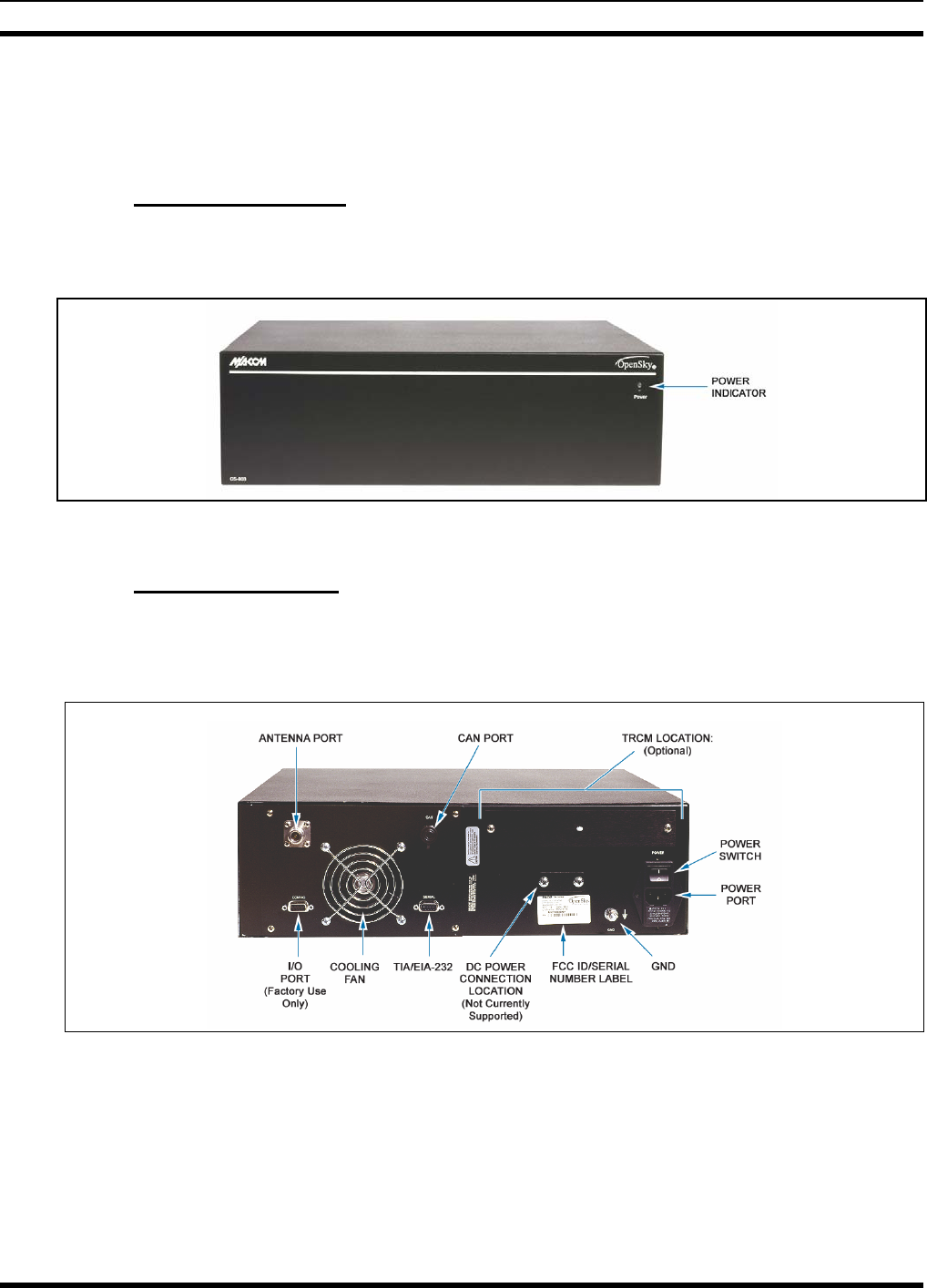
MM-011709-001
12
3 CS-7200/SP-103 OPERATION
3.1 CONTROLS AND INDICATORS
3.1.1 CS-7200 Front Panel
The CS-7200 front panel contains the mounting flanges, which allow for mounting into a standard 19”
rack. The power indicator light is located on the top right-hand side of the panel.
Figure 3-1: CS-7200 Front Panel
3.1.2 CS-7200 Rear Panel
The CS-7200 rear panel contains most of the cabling connections. The I/O connector contains radio-
specific functions. A serial port is provided for connection to a standard TIA/EIA-232 (DTE) device.
Connection to a Controller Area Network (CAN) device, such as the SP-103 Deskset, or TRCM-103, is
made through the 3-pin CAN connector. The CS-7200 is a CAN termination end-point.
Figure 3-2: CS-7200 Rear Panel
3.1.2.1 TRCM-103
Installation of the TRCM-103 option allows the user to connect to off-the-shelf Tone Remote Desk Sets.
See Section 4 for TRCM-103 Operating Instructions.
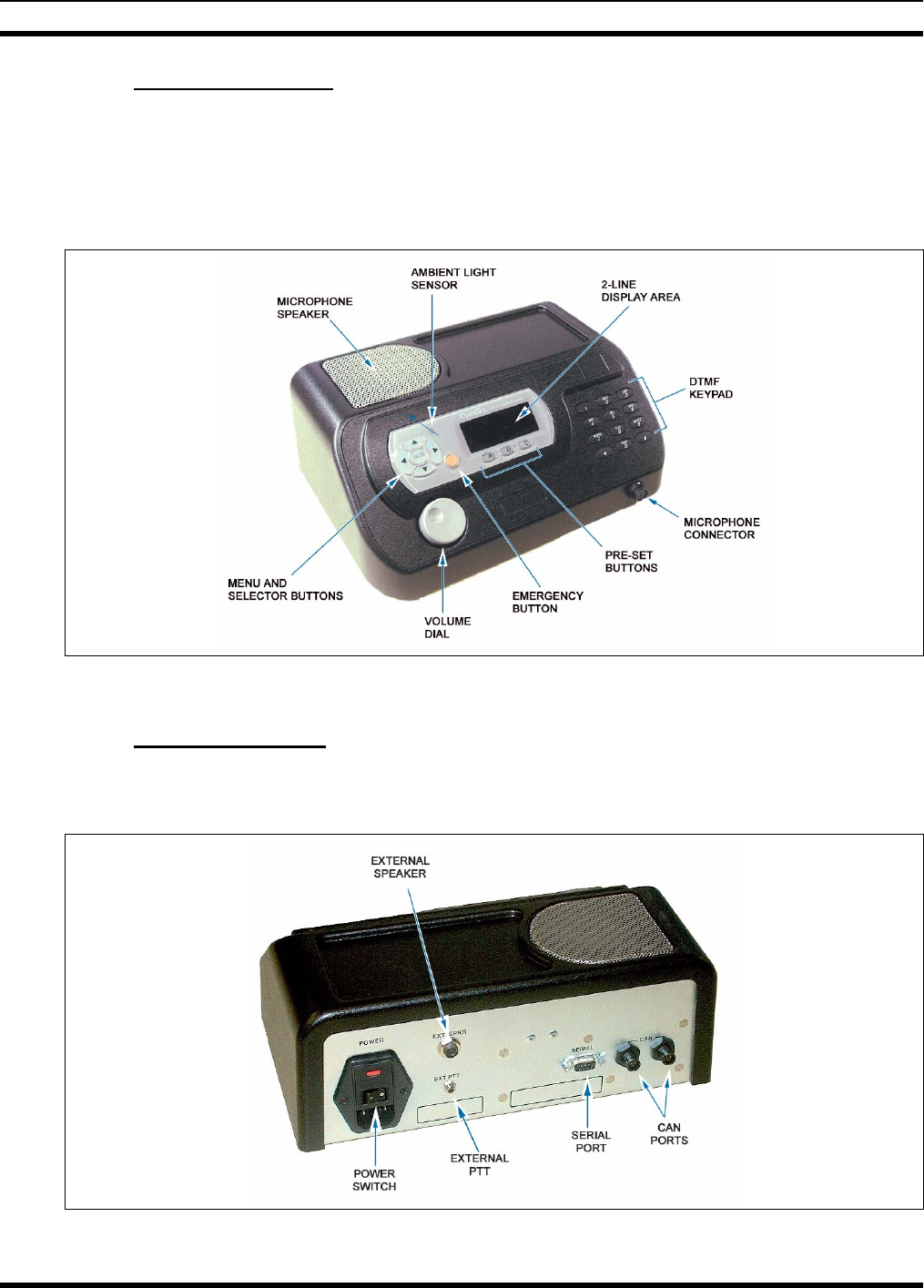
MM-011709-001
13
3.1.3 SP-103 Front Panel
The SP-103 front panel provides the CS-7200 user interface, which includes a 19-digit (8 over 11)
alphanumeric display panel, a menu and selector keypad, three pre-set buttons, a rotary volume control, a
microphone connector, emergency button, and 12-position DTMF keypad. In addition, the front panel
contains a photo-detector to sample ambient light level (used to automatically adjust display and button
backlighting brightness). See Table 3-1 for Controls and Functions overview.
Figure 3-3: SP-103 Front Panel
3.1.4 SP-103 Rear Panel
The SP-103 rear panel contains the interface connections necessary between the Deskset and the
CS-7200.
Figure 3-4: SP-103 Rear Panel
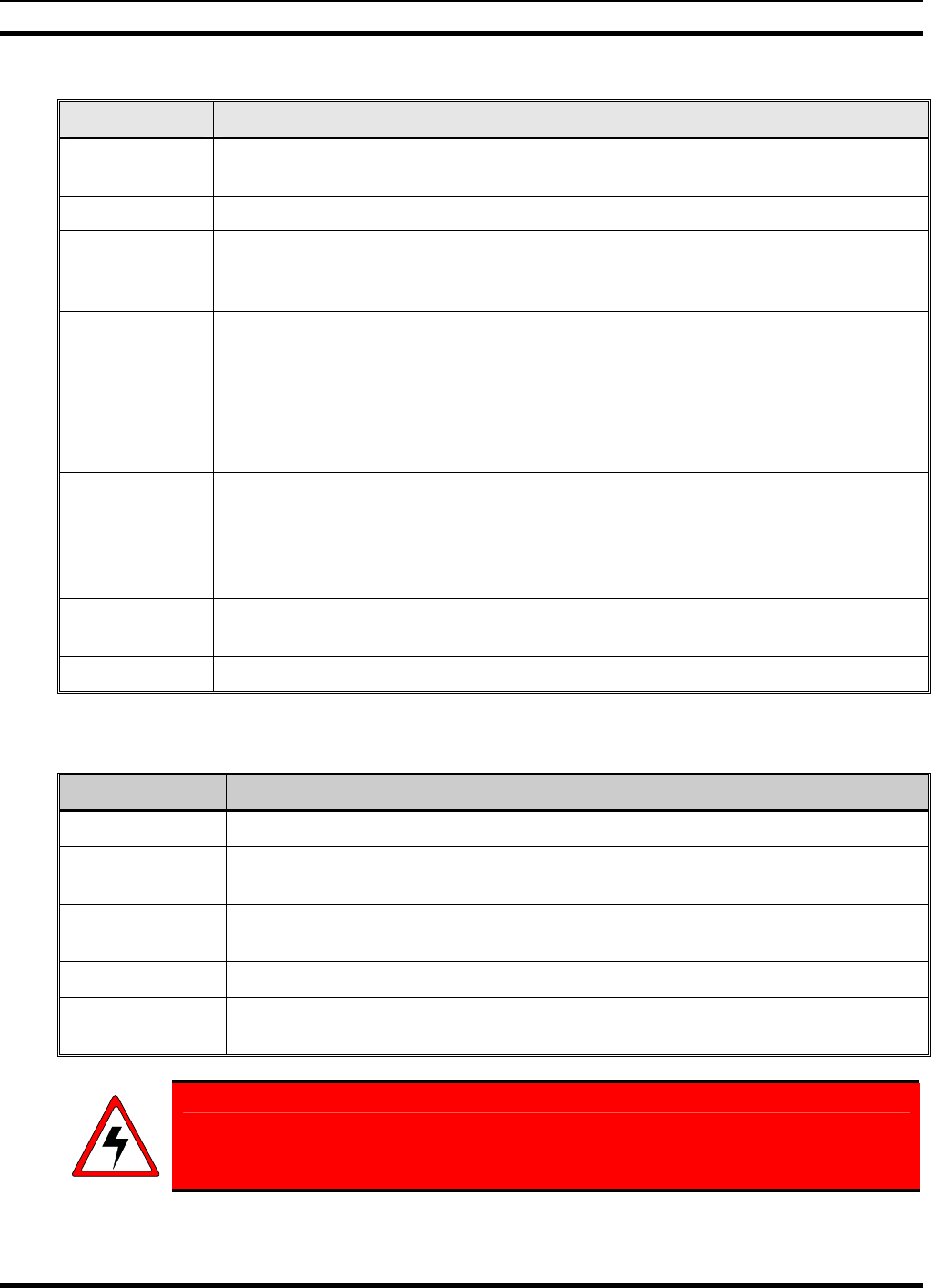
MM-011709-001
14
Table 3-1: SP-103 Front Panel Controls and Functions
CONTROL FUNCTION
Volume dial Twist clockwise to increase speaker volume. Twist counter-clockwise to decrease
speaker volume.
MIC connection Attach hand-held/hand-free microphone or headset.
Emergency
button
Pressing this button, if enabled through programming, will send an emergency alert
and will open voice communication on the currently selected talk group or the radio’s
default emergency talk group (depending upon how the system is defined).
Ambient light
sensor Automatically adjusts the display and button backlight brightness level based on
ambient light. Do not block this sensor.
Menu and
Selector buttons
Cycle through the menu loop with UP ▲ and DOWN ▼ buttons.
Scroll through selections with LEFT ◄ and RIGHT ► buttons.
Press SELECT button to activate the final selection.
Display area
Menu selections appear here, along with Network Connectivity and Volume level
indicators.
User may select which of several Dwell displays the SP-103 will display.
Refer to Table 3-4
Preset buttons These buttons are used to store and recall user-selectable parameters such as scan
mode, selected profile, selected talk group, and priority talk group.
DTMF keypad Allows for specific tasks such as entering a User ID and password, or selective calling.
Table 3-2: SP-103 Rear Panel Connections and Functions
CONNECTIONS FUNCTION
Power switch Press to Power Up/Down
Serial port Allows for transfer of data to and from a PC. Note that only one PC or data device
can be connected to the CS-7200 system at any given point in time.
CAN ports The two 3-pin CAN connectors are used to connect the SP-103 (a CAN device) to
the CS-7200 or to terminate the bus.
External PTT Provides interface for a footswitch PTT.
External Speaker Provides interface for connection to an external 10-Watt speaker. When an external
speaker is connected, the internal speaker is automatically muted.
Both conductors of the external speaker port are active and should not be grounded.
Connectors with exposed metal covers should not be used.
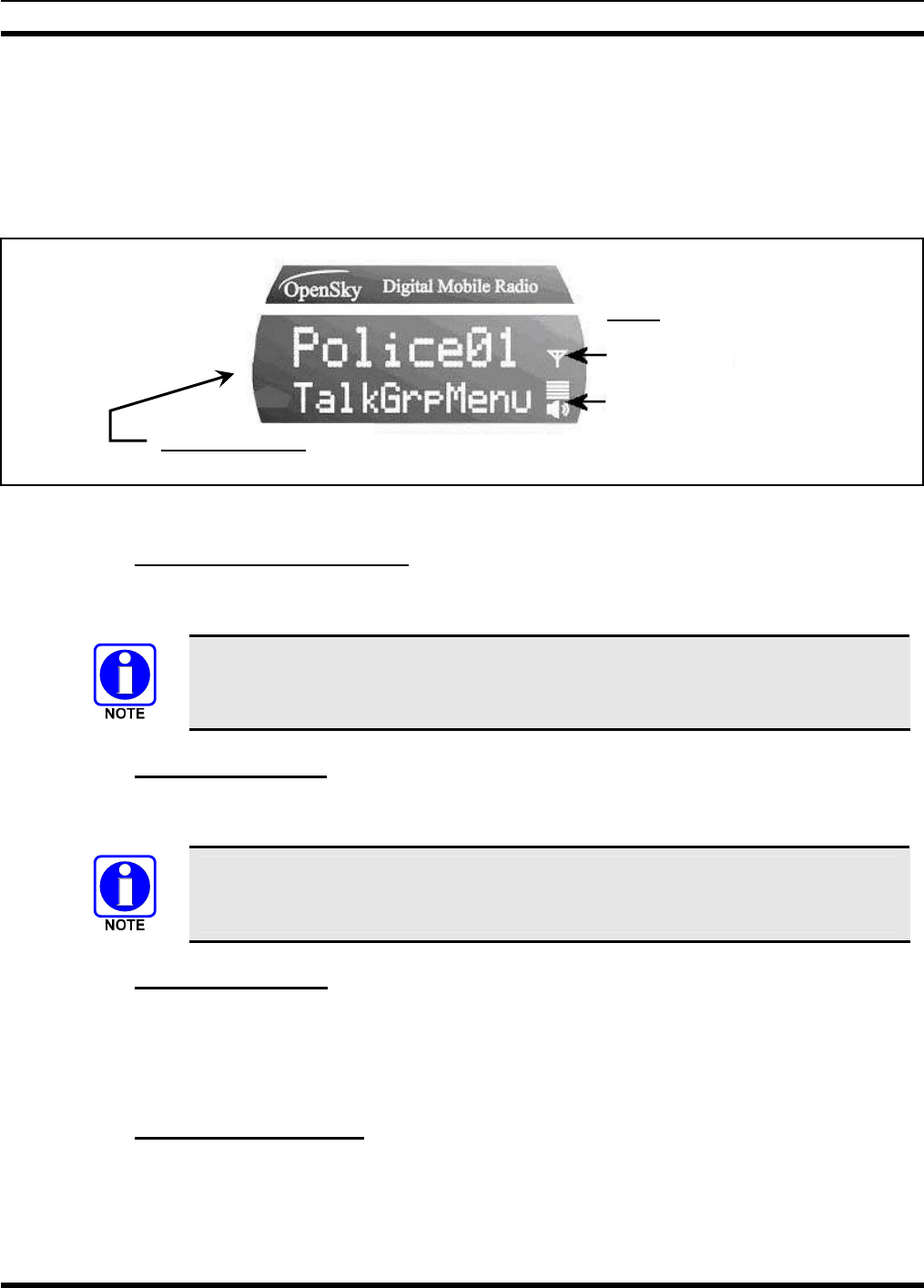
MM-011709-001
15
3.2 DISPLAY OVERVIEW
The display shows the radio status (Table 3-4). Network connectivity and volume icons appear on the
right. The volume level is also represented numerically within the display with zero (0 or muted) being
the lowest volume level and forty (40) being the highest/loudest level. “Mute” displays when the speaker
is muted. The rest of the display consists of two text lines that change in response to user interaction with
the menu buttons. A sample display is shown in Figure 3-5.
Figure 3-5: Sample Display (Talk Group Menu Session)
3.2.1 Network Connectivity Icon
The illuminated network connectivity icon (refer to Table 3-4) indicates network connectivity has been
achieved. This icon will always be illuminated when connected to the “network.”
Transmitting voice communications may be possible even if the Network Connectivity
icon is not illuminated. However, reception of voice calls, as well as transmitted audio
to users on other radio sites, is not guaranteed while in this state.
3.2.2 Volume Level Icon
As shown in Figure 3-5, the volume level icon indicates the current speaker/headset volume setting. Turn
the volume dial to change the setting.
In addition to the volume level icon at the right of the display, volume level is also
presented numerically within the display. This numeric representation only appears
during, and briefly after, the volume adjustment is made.
3.2.3 Display’s Top Line
The display’s top line of text changes as the and menu buttons are pressed to scroll through the
selections in the active menu. When the dwell display is present, press the and buttons to scroll
through available talk groups. The top line of the display also indicates other information such as the
selected talk group when the dwell display is active, and alert messages.
3.2.4 Display’s Bottom Line
The display’s bottom line of text changes as the c and d menu buttons are pressed to scroll through the
menus. The menu structure is shown in Table 3-3. The bottom line of the display also indicates other
information such a login prompt, emergency status, and dwell display messages as described in the
following section.
Icons
Network
Connectivity
Volume Level
Two Text Lines
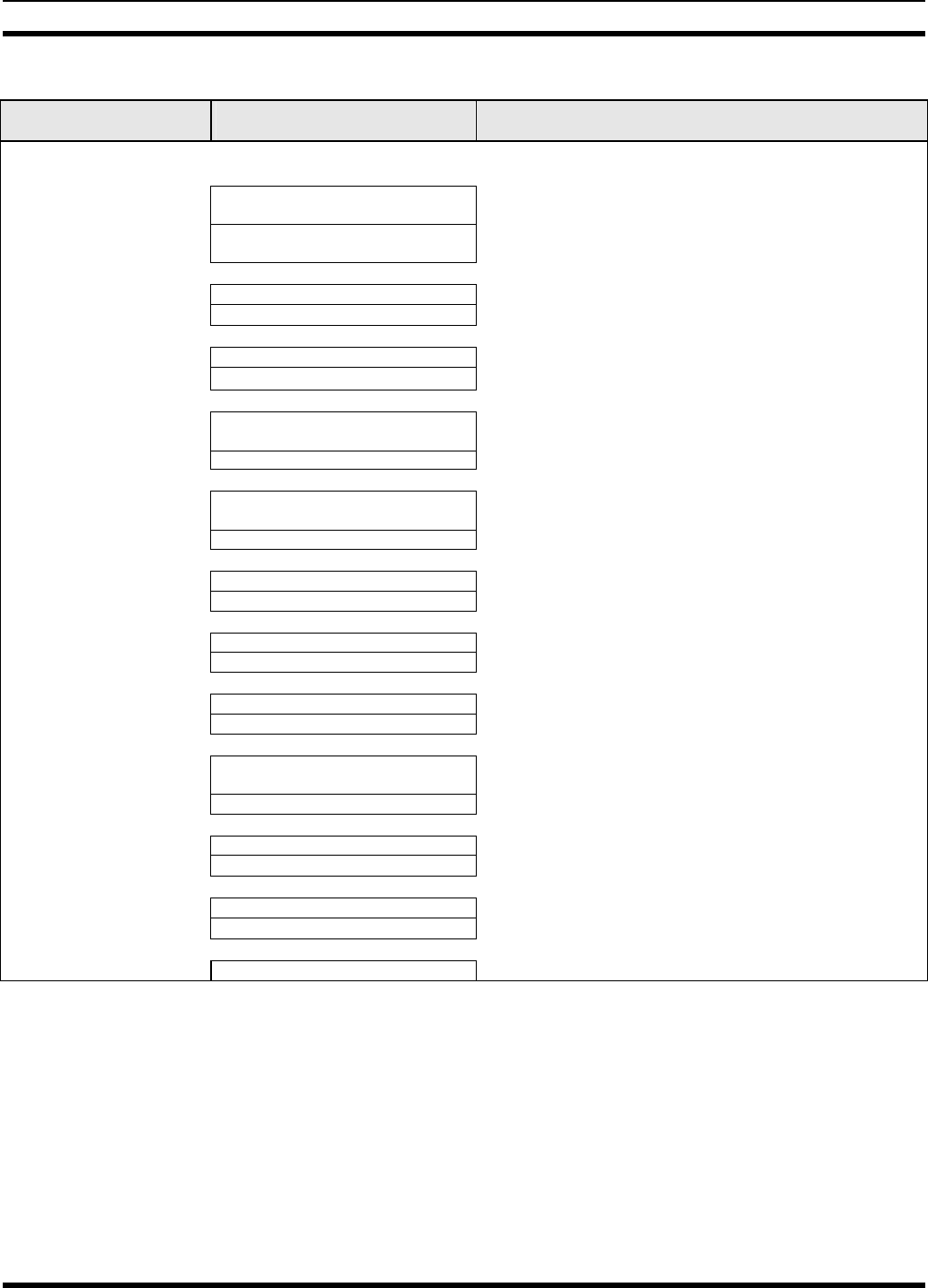
MM-011709-001
16
Table 3-3: Basic Menu Structure
Menu Name Radio Displays
(first and second lines) Usage Notes
To/From Dwell Display
▲ ▼
registration, RF sync and
transceiver status codes
Engineering Display
(Menu may not be available
per programming.) bit-error rates
and RSSI data
Displays radio system connection data. For engineering use.
▲ ▼
OFF/ON
Silent Emergency “SilentEmerg”
Use ◄ or ► to toggle between OFF/ON. Press Select to
enable.
▲ ▼
available modes
Operating Mode
(e.g., OTP, OCF) “Mode Menu”
Use ◄ or ► to turn choose an available mode. Press
Select and confirm (Y/N) with ◄ or ► and Select again.
▲ ▼
current latitude and longitude
(degrees:minutes:seconds)
GPS Fix
“GPS Fix”
GPS latitude and longitude position of currently tuned-to
base station [“GPS (Site)”] scrolls across top line of the
display.
▲ ▼
User ID # of user currently logged
in
User ID
“User ID”
User’s identification/name scrolls across top line of the
display (if programmed).
▲ ▼
Radio’s IP address
IP Address “IP Address”
Radio’s Internet Protocol (IP) address scrolls across top line
of the display.
▲ ▼
station’s call sign
Station Identification “Station ID”
Station’s identification/name scrolls across top line of the
display (if programmed).
▲ ▼
“OFF”
Stealth Mode
(display backlight is disabled) “StealthMenu” Use ◄ or ► to turn on. Press any button to turn it off.
▲ ▼
“LOW”, “MEDIUM”, “MEDHIGH”,
“HIGH”
Treble Level
“Treble Menu”
Use ◄ or ► to choose speaker treble level. Press Select to
return to dwell display.
▲ ▼
“<< >>”
Display Brightness “Bright Menu”
Use ◄ or ► to brighten or dim backlighting. Press Select to
return to dwell display.
▲ ▼
“OFF”, “LOW”, “MED”, HIGH”
Side Tone Level “Side Menu”
Use ◄ or ► to choose side tone level. Press Select to
return to dwell display.
▲ ▼
See Next Page
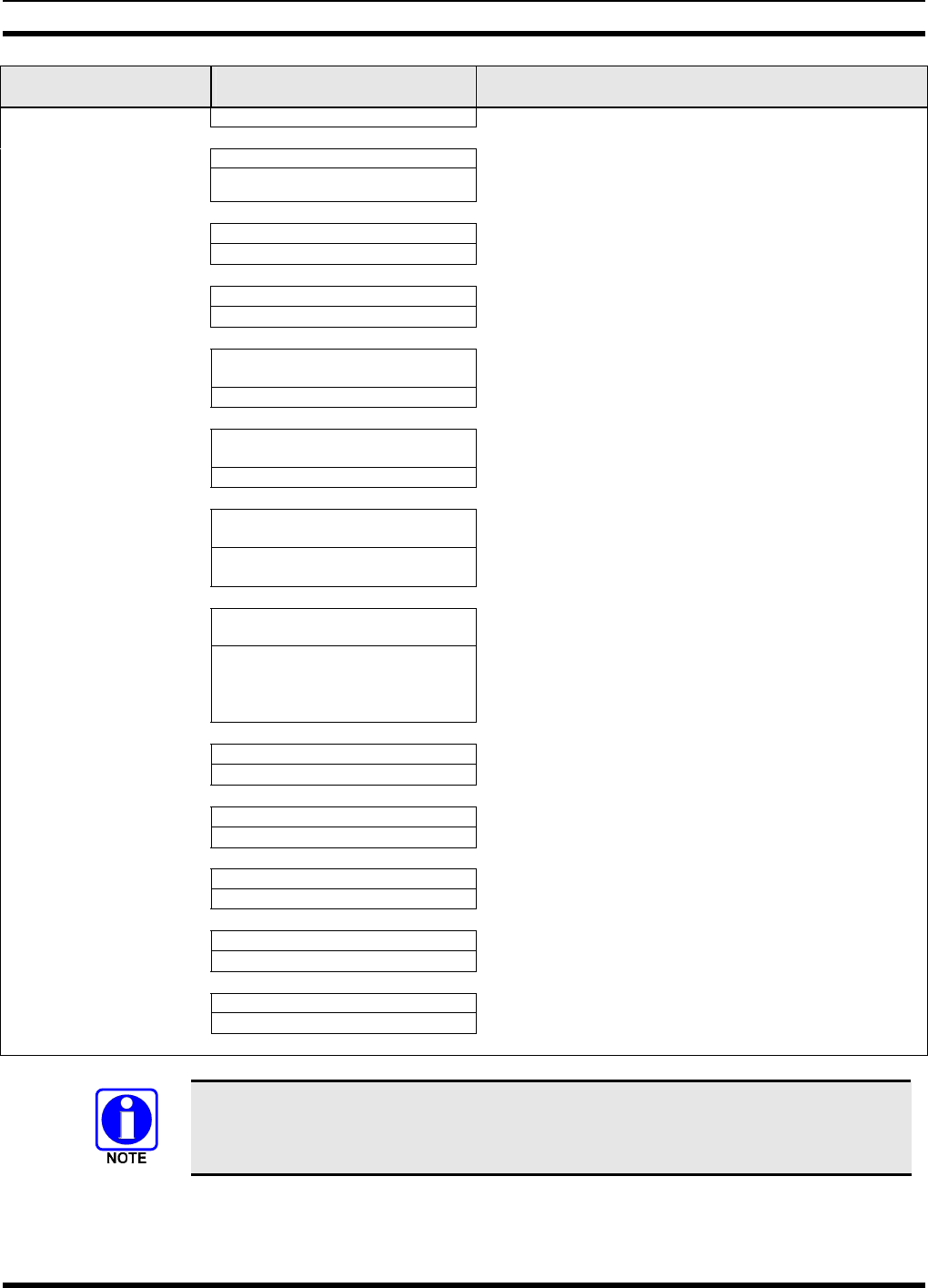
MM-011709-001
17
Menu Name Radio Displays
(first and second lines) Usage Notes
See Previous Page
▲ ▼
selected channel Selected Channel
(Menu may not be available
per radio programming) “ChannelMenu”
Displays the current channel. Press Select to return to dwell
display.
▲ ▼
current scan mode
Scan Mode
(e.g. Normal, No Scan, Fixed) “ScnModeMenu”
Use ◄ or ► to turn scan on and off. Press Select to return
to dwell display.
▲ ▼
talk group “<”
Talk group
Lock Out “LockOutMenu”
Use ◄ or ► to choose a talk group for locking/unlocking.
Press Select to toggle “<” on (locked out) and off.
▲ ▼
Priority 2
Talk group current priority talk group
“Priority2”
Use ◄ or ► to choose Priority 2 talk group. Press Select
to return to dwell display.
▲ ▼
Priority 1
Talk group current priority talk group
“Priority1”
Use ◄ or ► to choose Priority 1 talk group. Press Select
to return to dwell display.
▲ ▼
Alerts Received time/sender’s name/
alias/message text
“AlertsRcvd”
or oldest message
“No alerts” or alert message text scrolls in display. Use ◄
or ► to view all messages.
▲ ▼
current speed dial #
Alert Destination
“AlertDest”
Use ◄ or ► to choose a speed-dial number. Press Select
to go to the “Alert Msg” menu. Use ◄ or ► to scroll
through “canned messages.” Press Select to send
message and return to dwell display.
▲ ▼
Speed Dial current speed dial #
“SpeedDial”
Use ◄ or ► to choose a speed-dial number and press
PTT to place call.
▲ ▼
Profile Selection currently active profile
“ProfileMenu”
Use ◄ or ► to choose an available profile. Press Select to
return to dwell display.
▲ ▼
Talk group Selection selected talk group
“TalkGrpMenu” Use ◄ or ► to choose a talk group in current profile.
▲ ▼
Emergency Dismiss alert received
“EmgDismiss”
Use ◄ or ► to choose emergency talk group. Press
Select to toggle “<” on (dismiss) and off.
▲ ▼
Dwell Display selected talk group
(bottom line option)
Use ◄ or ► to scroll top line through talk groups. Press
Select to change bottom line option.
Use ▲ and ▼ to scroll through menus.
Menus will vary depending upon system programming, radio hardware, and optional
configurations. All menus except the dwell display menu can be turned off by network
administration personnel.
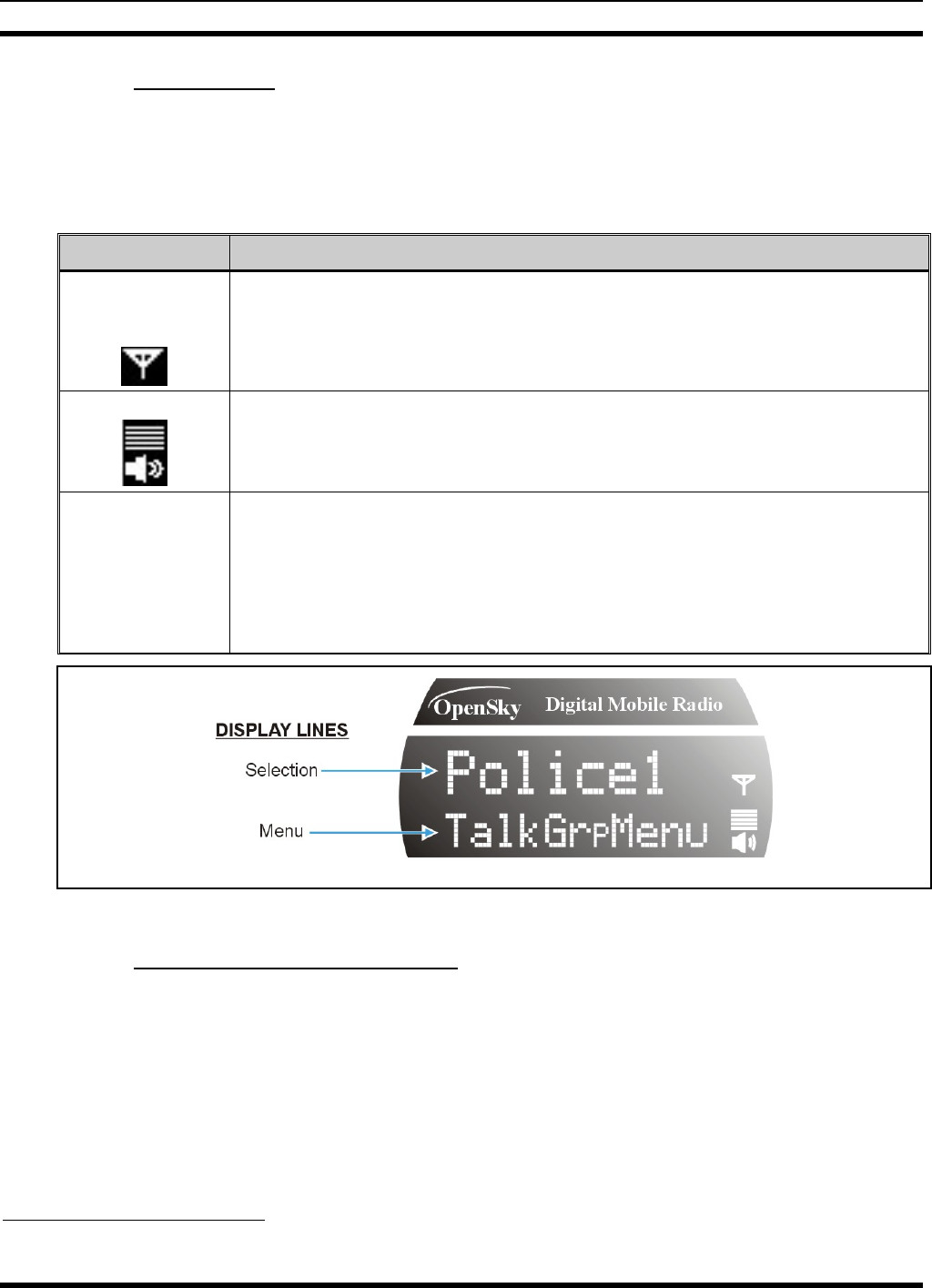
MM-011709-001
18
3.2.5 Dwell Display
When not engaged in menu selection, the 2-line display defaults to the user-defined default display,
known as the “dwell display.” The top line indicates the currently selected talk group. The bottom line
indicates the currently selected profile, received talk group/caller ID/alias1 or radio channel. To set one of
these bottom line options, press the Select button from the dwell display.
Table 3-4: Display Parts and Functions
COMPONENT FUNCTION
Network
Connectivity
Icon
When the network connectivity icon is illuminated, there is a network connection
and not illuminated when there is no network connection.
Volume Icon
Shows current speaker volume setting chosen by the user. Note that a momentary
numerical representation will also be shown within the display while the volume is
being adjusted.
TWO TEXT
LINES
During a menu session, the display’s bottom line responds to (up arrow) and
(down arrow) buttons. It indicates the current menu. For example, the Talk group
Menu is selected in Figure 3-6.
The display’s top line responds to the (left arrow) and(right arrow) buttons. It
indicates the options within the current menu. For example, “Police1” is the
currently selected talk group in Figure 3-6.
Figure 3-6: Top and Bottom Display Lines
3.2.6 Menu Display and Control Area
Following power-up, the display shows the default talk group. Pressing the c and d buttons change the
display to the next available menu. Refer to Table 3-3. In many cases, the dwell display automatically re-
appears after no menu buttons are pressed for a short period of time (between 10 and 30 seconds). For
some menus such as the User ID menus, this does not occur until the user presses a front panel button.
When the dwell display is active, it will change dynamically to reflect the current profile, received talk
group/caller ID (when available), or channel (when enabled).
The display is highly interactive. It responds in the top and bottom text lines as the user presses the menu
buttons (c, d, ◄, ► and Select) to scroll through the menu loop and the entries for each menu.
1 Alias is a logical ID name such as “J_Smith.” The name corresponds to a user ID such as 003-542-0001. Alias is limited to eight (8) characters.
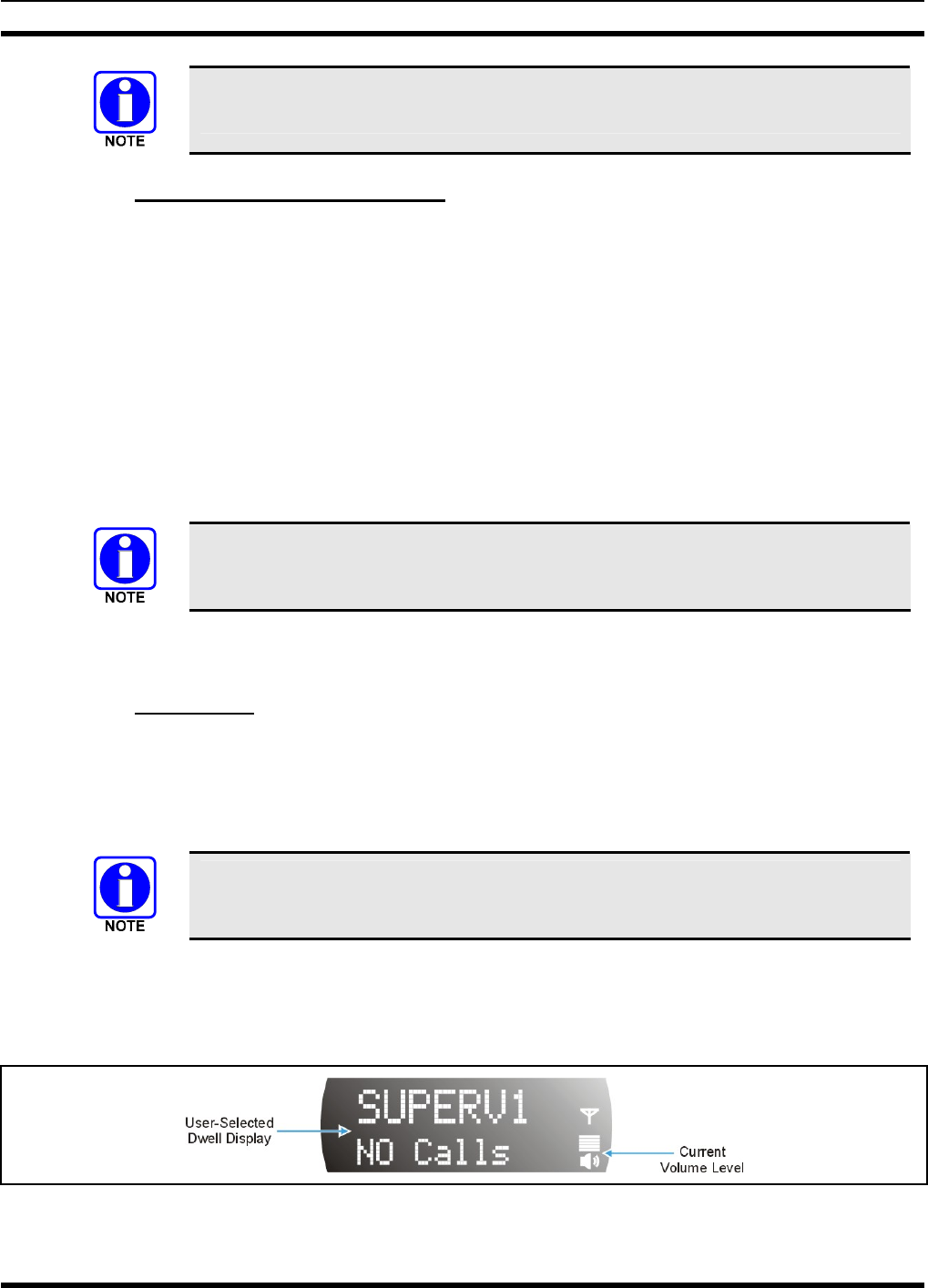
MM-011709-001
19
Although the display supports eight (8) characters on the top line, systems currently
limit talk group names to seven (7).
3.2.7 Dwell Display User-Selectable
The top line of the dwell display for OpenSky trunked mode operation is always the selected talk group
for the profile of the particular radio. What appears in the bottom line depends on the choice made as a
dwell display option. From dwell display, press Select to change the bottom line display option by
cycling through available options.
Whatever the preference, the radio will respond dynamically to changes in status, always displaying the
current information about the current network connection. The bottom line indicates the currently selected
profile, received talk group/caller ID/alias or radio channel. To set one of these bottom line options, press
the Select button from the dwell display. If a menu is not enabled it is not available for display in the
bottom line of the dwell display.
Table 3-3 shows the Basic Menu Structure and some options available. Available profiles, talk groups,
and channels vary widely from network to network depending on system hardware, and option
configuration.
Visible menu items will vary depending on the system, hardware, and option
configuration.
3.3 BASIC RADIO OPERATION
3.3.1 POWER UP
1. Press the power switch on the CS-7200 rear panel. The front panel LED will illuminate.
2. Press the power switch on the rear panel of the SP-103. The display will show, “Booting. Please
wait.”
3. Wait through the startup sequence, which lasts approximately 10 seconds.
If the startup sequence lasts longer than 10 seconds or if “No MRU” appears on the
SP-103 display, the Control Station has not powered up correctly or no CAN
connection is present. See section 3.1.4.
During this time, if enabled for auto registration, the radio is provisioned with a customized user
personality designed for the user’s specific needs by the Network Administrator.
4. When provisioning is complete, the dwell display will appear on the SP-103 display and the Volume
icon will indicate the current speaker volume setting.
Figure 3-7: Dwell Display and Speaker Volume Icon
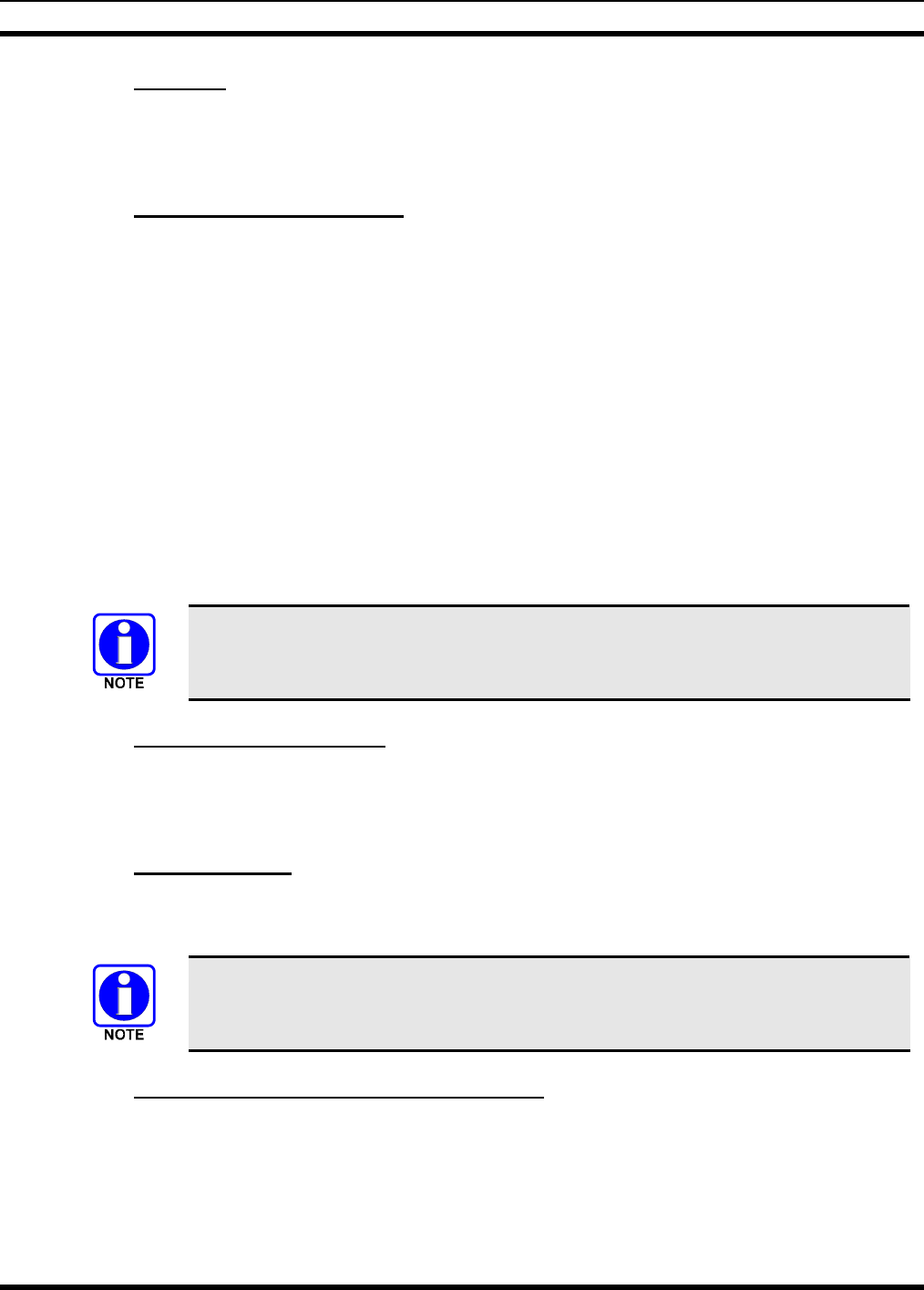
MM-011709-001
20
3.3.2 Self-Test
After power-up, the CS-7200 undergoes a multi-function automatic registration procedure and self test.
As many as sixteen (16) possible radio profiles are downloaded from the network in response to the
User’s ID.
3.3.3 Logging In to the Network
Login occurs either automatically (auto registration) if the radio has a valid registration or, if enabled and
authorized for encryption (section 3.12), requires the user to enter a User ID and password.
If encryption is enabled and authorized, the user will be prompted to “Pls Login” with the *1 login
command, a User ID, and password.
1. Press *1 (Login command).
2. Enter the full 10-digit User ID.
3. Press the # key.
4. Enter the password.
5. Press the # key twice.
The User ID may be remembered from the previous log-in. (Refer to Section 3.3.4 for further details
regarding log-off commands.) The password will be established before the radio is put into operation.
Contact the local OpenSky network administrator for more information.
If necessary, contact radio system administration personnel for log-in assistance and/or
radio-specific log-in instructions.
3.3.4 Logging off the Network
The *0## command un-registers the radio. Typically, it is automatically performed when powering down
the radio using SP-103 Power Button. The User ID is remembered by the radio so only the password is
needed at next log-in.
3.3.5 POWER DOWN
Press the A/C power switches on the SP-103 (Figure 3-3) and CS-7200 rear panel (Figure 3-2) to power
down.
The CS-7200 configuration will not be saved if power is removed prior to saving.
3.3.6 Receiving and Transmitting Voice Calls
As soon as the startup/log-on/provision/self-test sequence and registration on the OpenSky network is
complete, voice calls from talk groups in the active profile will be audible.
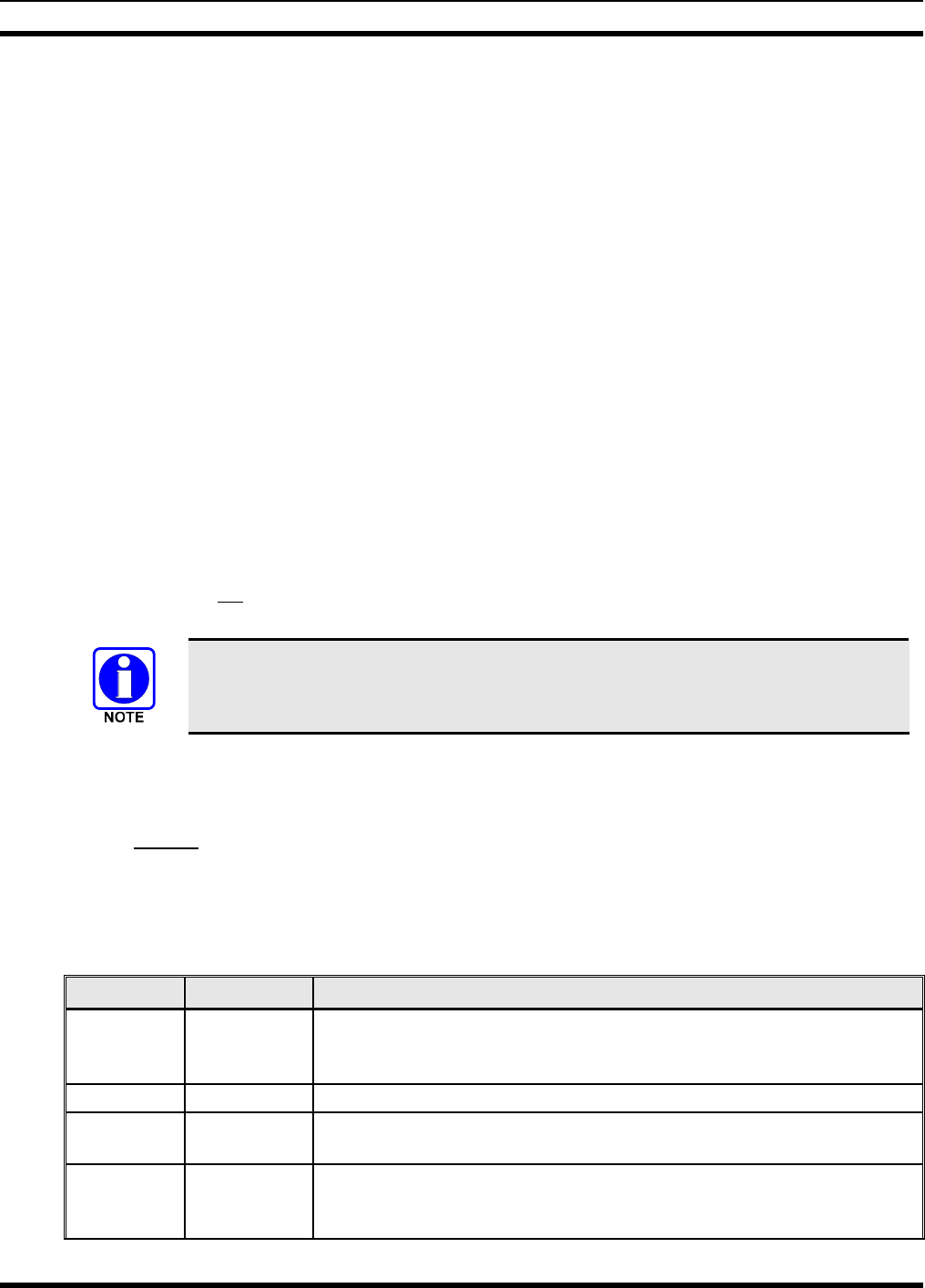
MM-011709-001
21
3.3.6.1 Receiving a Voice Call
No action is required to receive a voice call. The display responds to incoming voice calls as follows:
• If the dwell display is set to the received talk group/caller ID/alias, the display indicates either the
User ID of the incoming caller, if available, or the talk group’s name. If the selected talk group
matches the receive talk group, caller ID/alias is displayed. Otherwise, the talk group (name) is
displayed.
• If the dwell display is not set to the received talk group, the display indicates the data appropriate to
those displays, but provides no indication as to the identity of the incoming caller.
Refer to section 3.6 for detailed information on talk group scanning. Refer to section 3.12 for detailed
information regarding sending and receiving encrypted calls.
3.3.6.2 Transmitting a Voice Call
Transmit a voice call as follows:
1. Ensure power is supplied to the CS-7200. See section 3.3.1.
2. If required, log-in to the network using a user ID and password. See section 3.3.3.
3. Select the desired talk group for transmitting on.
4. Depress and hold the Push-to-Talk (PTT) button on the microphone, pause for a moment, and then
speak normally. For maximum clarity, hold the microphone approximately 1 ½ inches from the
mouth and do not shout or whisper into it. If the call is queued by the network, wait for the grant tone
to sound before speaking.
The PTT button is located on either the SP-103 Deskset stand mic, the side of the
hand-held mic or on the foot switch.
5. Release the PTT button when finished speaking.
Refer to section 3.12 for detailed information regarding sending and receiving encrypted calls.
3.3.7 Tones
In addition to the volume level tones (sounded momentarily only when volume level is adjusted) and
confirming tones (sounded momentarily when a menu or option is selected), the radio provides the tones
described in Table 3-5.
Table 3-5: Alert Tones
NAME TONE DESCRIPTION
Call Queued one low
tone/two high
tones Call queued for processing.
Call Denied 3 short Radio is out of coverage area or requested talk group is active.
Grant (or Go-
Ahead) single short
beep Sounded when resources become available for a call request placed in the
queue (if enabled) upon channel access
Call
Removed
single long
low-pitched
tone
Notifies the user access to the channel has been lost (out of coverage area
or preempted by higher-priority call)

MM-011709-001
22
NAME TONE DESCRIPTION
Selective
Alert
Received 4 short tones Only played once to indicate a selective alert has been receive
Emergency
Alert Tone 3 short beeps Sounds when an emergency alert is declared
Emergency
Cleared Tone one long low-
pitched tone Sounds when and emergency is cleared
Selective Call
Ring Tone
a ringing tone
similar to a
telephone
Ringing is repeated every 4 seconds until the call is accepted or rejected
by the radio being called or until the network drops the call if unanswered
after 1 minute
PSTN Ring
Tones
single
medium-pitch
reiterative
tone
Two ring tone - one generated by the radio when there is an incoming
telephone call or an outgoing telephone call attempt is waiting for the
telephone interconnect gateway equipment to dial the Public Switched
Telephone Network (PSTN). The second ring tone sounds when the
gateway equipment has dialed the number.
Roam Tone a quick high-
low beep
sequence
Sounds when the radio transitions from one radio base station site to
another. If this tone sounds just after pressing the PTT button, keep the
PTT button depressed and begin speaking into the microphone after the
grant tone sounds.
3.3.8 Adjusting Side Tone Audio Level
The SP-103 sounds confirming tones called “side tones” when its buttons are pressed. Most users find this
audible confirmation helpful when navigating the menus. Side tone audio level can be adjusted or turned
completely off using the “Side Menu.”
If the radio is operating properly but side tones are not heard when the menu buttons are pressed, the side
tones are probably turned off. To turn them back on, access the “Side Tone” menu and select a setting
other than “off.”
Use the following procedure set side tone level:
1. Use the ▲ and ▼ buttons to cycle through the menu until the “Side Menu” appears in the bottom line
of the display.
2. Use the ◄ or ► buttons to change to the desired level (Off, Low, Medium, or High). To turn side
tones completely off, use the “Off” setting.
3. Press the Select button to confirm and begin using the side tone level setting. The dwell display will
appear when the radio begins using the new setting.
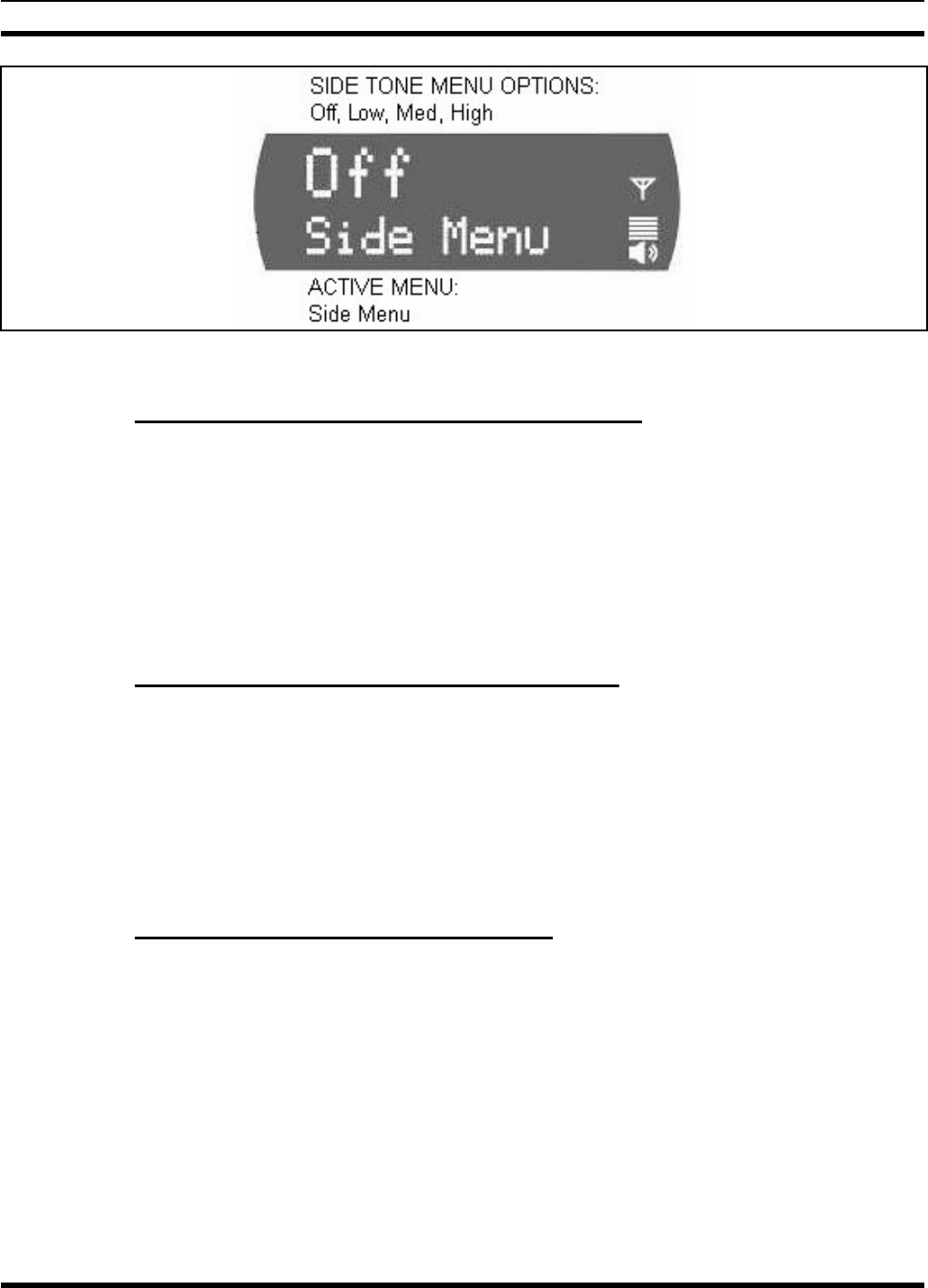
MM-011709-001
23
Figure 3-8: Side Tones Menu
3.3.9 Adjusting Display & Button Backlight Brightness
The SP-103 uses a light sensor on the front panel to automatically adjust display brightness and button
backlight brightness to ambient light conditions. The display and backlights automatically brighten at
higher external light levels and automatically dim at lower external light levels. However, the “Bright
Menu” gives the user some manual brightness control as follows:
1. Use the ▲ or ▼ button to scroll through the menu until “Bright Menu” appears. A “<< >>” symbol
appears in the top line of the display.
2. Use the ◄ button to reduce the brightness or the ► button to increase the brightness. Display and
button backlight brightness will immediately dim or brighten.
3.3.10 Adjusting Speaker/Headset Audio Treble Level
The tone of received signals heard in the speaker and headset can be adjusted using the radio’s “Treble
Menu” as follows:
1. Use the ▲ or ▼ button to scroll through the menu until “Treble Menu” appears. The current treble
level setting indicates in the top line of the display. There are four (4) levels available: low, medium,
medium-high and high.
2. Use the ◄ button to reduce the treble level setting or the ► button to increase it.
3. Press the Select button to return to the Dwell Display.
3.3.11 Checking or Changing the Active Profile
The radio can store up to sixteen (16) standard profiles within its personality, one of which is always set
as the currently active profile. Each profile can contain up to sixteen (16) talk groups. Each profile is
typically configured to contain those talk groups specific to certain communication activities, such as
police patrol.
If the dwell display is set to “profile,” the currently active profile’s name appears in the bottom line of the
display. Otherwise, to determine which profile is currently active, use the menu buttons to access the
Profile Menu. The active profile’s name will appear in the top line of the display. To switch to/activate a
different profile:
1. Press the c or d button until “ProfileMenu” appears in the bottom line of the display. The name of
the currently active profile appears in the top line. For example, “TacNet” as shown in Figure 3-9.
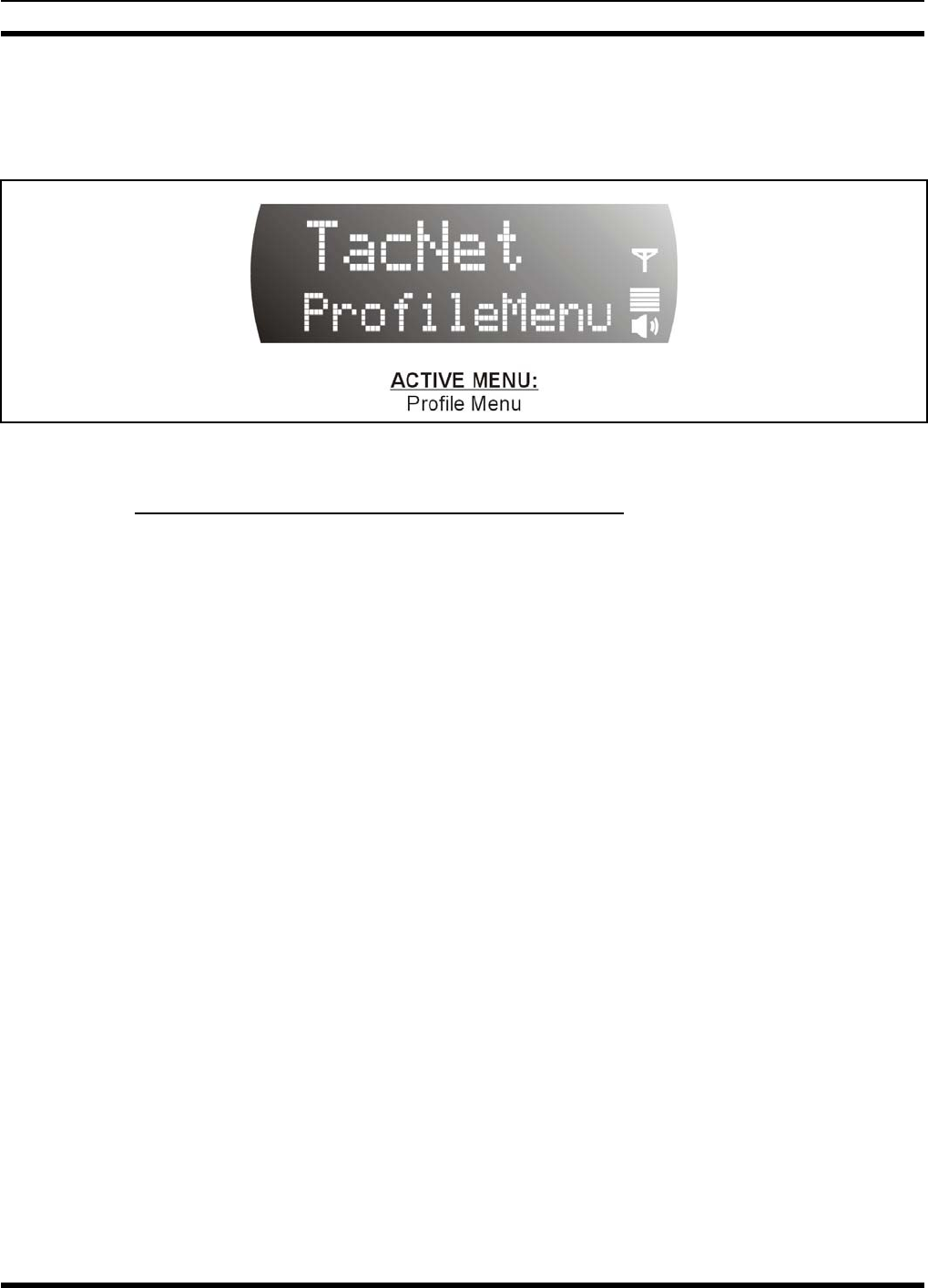
MM-011709-001
24
2. Press the ◄ or ► buttons to choose the desired profile stored in the radio as established by the
OpenSky network administrator.
3. Press the Select button to activate the newly chosen profile. After a short time (a few seconds), the
newly chosen profile activates and the dwell display re-appears.
Figure 3-9: Profile Menu
3.3.12 Checking or Changing the Selected Talk Group
Each profile stored in the radio can have up to sixteen (16) talk groups. One talk group within the
currently active profile is set as the “selected talk group.” The selected talk group is typically the focus of
most voice transmissions and receptions. There are two ways to change the selected talk group:
First Method:
1. Use the ▲ and ▼ buttons to scroll through the menu until “TalkGrpMenu” appears on the bottom
line of the display. The currently selected talk group appears in the top line of the display. For
example, “Police1” as shown in Figure 3-10.
2. Use the ◄ or ► buttons to scroll through the available list of talk groups in the active profile. This
list is determined by the OpenSky network administrator.
OR
Second Method:
From the dwell display, press the or buttons to scroll through the available list of talk groups in the
active profile.
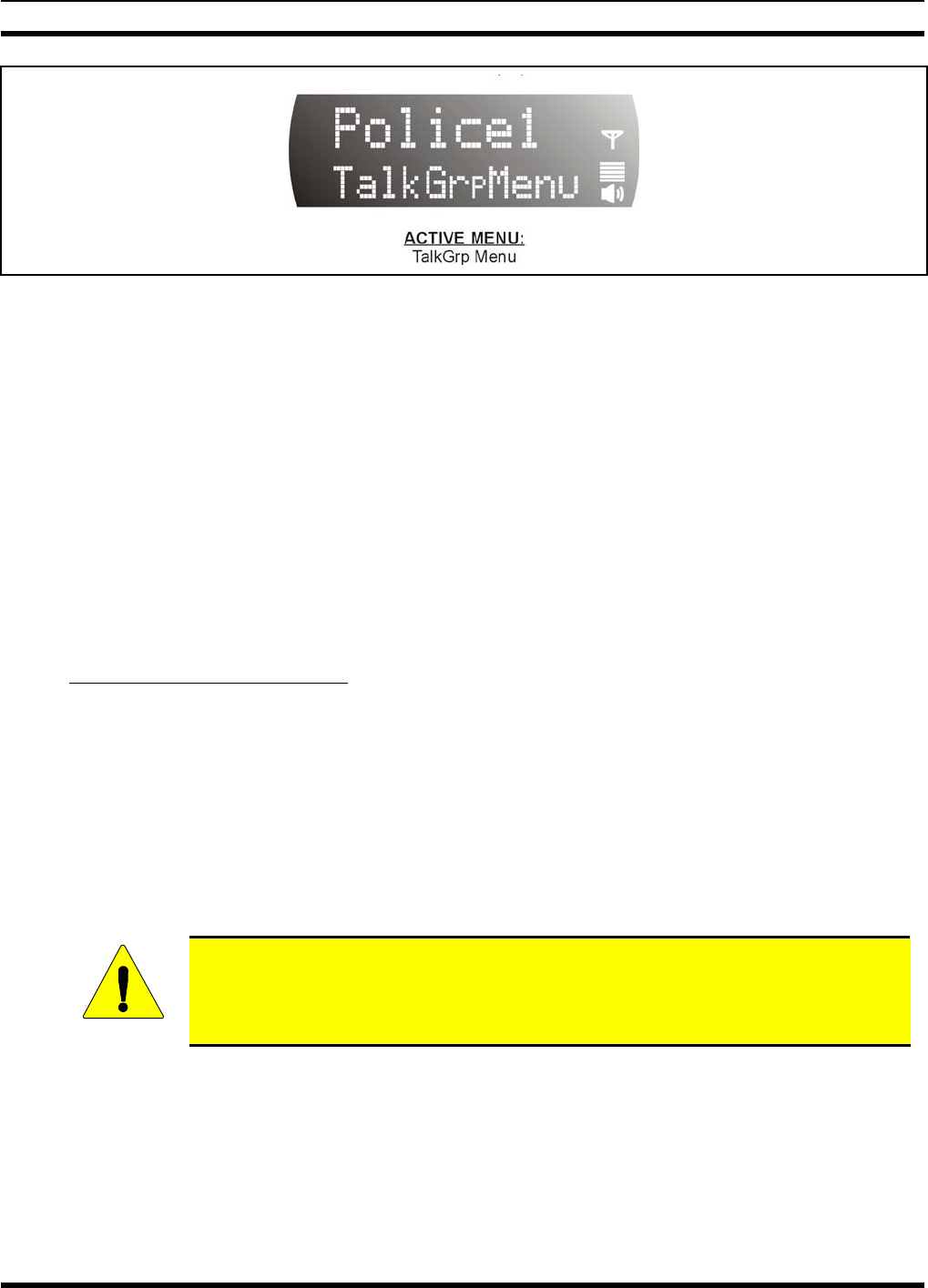
MM-011709-001
25
Figure 3-10: Talk Group Menu
3.4 INTERCOM MODE
Intercom mode menu option is available when the CS-7200 detects multiple Desksets at power-up.
Intercom mode allows multiple desksets on the same CS-7200 to communicate with one another, without
transmitting over the air. INTERCOM will appear in the top line of the display panel and “On” or “Off”
will appear in the bottom line.
Incoming voice calls will override intercom communications for the duration of the voice call. The
Control Station will still be in Intercom mode and intercom communications will resume when the voice
call ends.
Use the following procedure to change Intercom mode settings:
1. Use ◄ or ► to turn Intercom mode ‘On’ or ‘Off.’
2. Press Select to confirm choice.
When intercom mode is turned on:
• Incoming voice calls will override intercom communications for the duration of the voice call. The
desksets remain in intercom mode and intercom communications will resume when the voice call
ends.
• “TG: INTERCOM” appears in the display when talking on the intercom. This indicates microphone
audio is not sent out on the selected talk group; rather, it remains localized between the radio control
positions.
• If a call exists on the currently selected talk group when a PTT button is pressed at one of the desk
sets, “TG: in use” appears in the display to indicate intercom mic audio cannot preempt the call on the
talk group.
CAUTION
A user at a CS-7200 with only one SP-103 can turn intercom mode on. In this case,
pressing the microphone’s PTT button will not send microphone audio anywhere.
3.5 TALK GROUP LOCK OUT
There are two ways of focusing voice communications by suppressing calls from talk groups in the
currently active profile:
1. No Scan. By turning scan off (selecting “No Scan” via the “ScnModeMenu”), only the selected talk
group is audible.
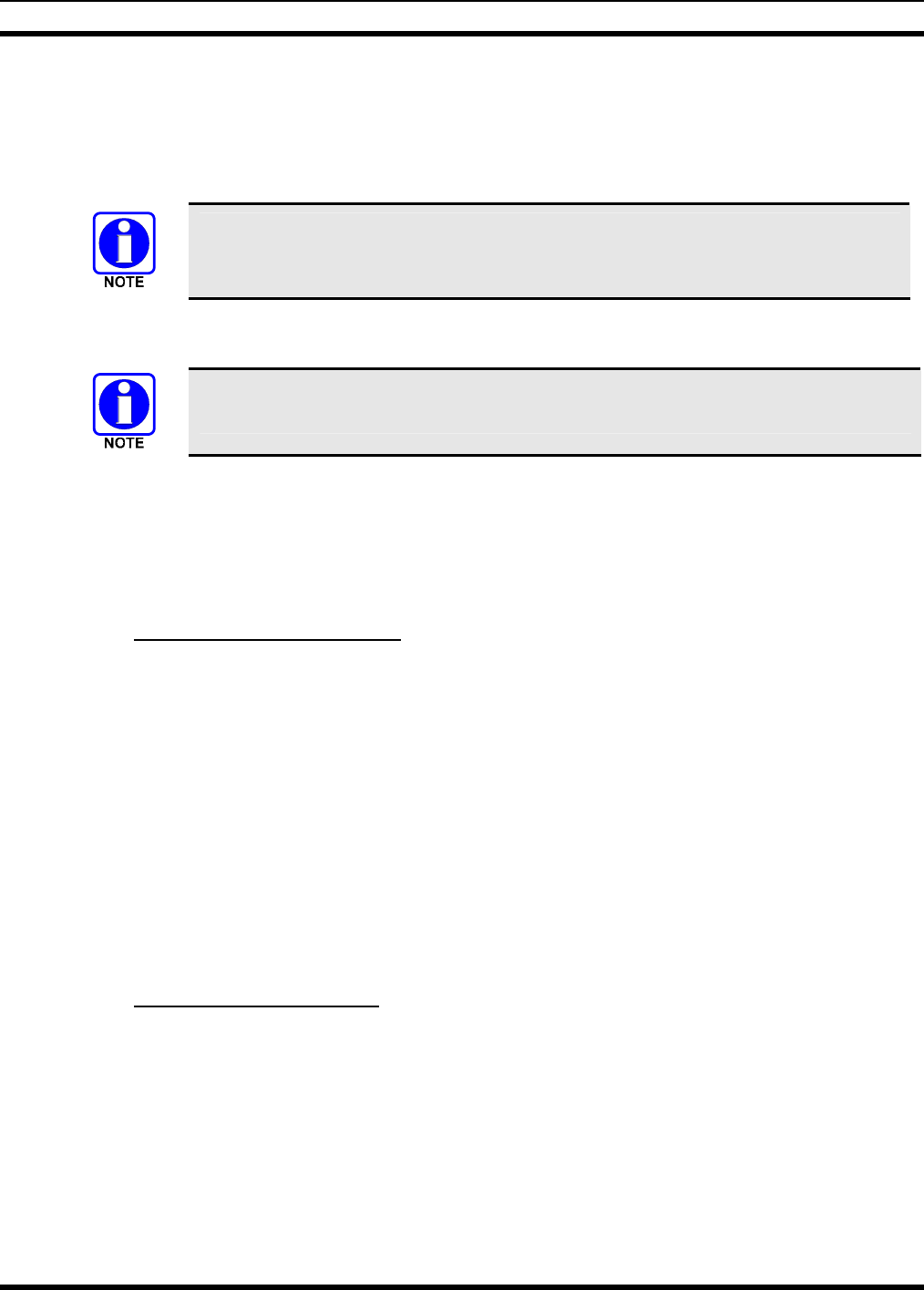
MM-011709-001
26
2. Lock Out. By locking out selected talk groups, the “chatter” of the locked-out talk groups cannot be
heard. This focuses the user’s scanning resources to calls only on desired talk groups.
Talk group lock out is a scan-related feature. With lock out, one or more talk groups in the active profile
can be temporarily disabled from being scanned. Calls are not received on locked-out talk groups. Lock
out settings are not retained between profile changes or when the radio is power cycled.
Lock out is a listening (receive) function and only blocks received calls on locked out
talk groups. Lock out does not affect transmit capability. The above methods do not
apply to recent emergency lock outs.
Only talk groups in the active profile can be locked out, since they are the only talk groups whose voice
calls can be heard.
If the Scan Mode is “Fixed,” P1 and P2 groups CANNOT be locked out. See Section 3.6 for
more information.
The default emergency and emergency-capable talk groups can be locked out if they are NOT in an
emergency state. If a talk group is locked out and is subsequently changed to the currently selected talk
group, it will automatically be unlocked by the radio so the user can hear calls on the talk group. The
radio may be configured so all talk groups are automatically locked out by default. In this case, they must
be manually unlocked, if desired.
3.5.1 Locking Out a Talk Group
1. Use the ▲ or ▼ button to scroll through the menu until “LockOutMenu” appears in the bottom line
of the display. The name of a talk group in the currently active profile will appear in the top line. See
Figure 3-11.
2. Use the ◄ or ► buttons to scroll through the list of talk groups, if any, until the desired talk group for
lock out appears in the top line of the display.
3. Press the Select button to lockout the displayed talk group. A less than symbol (<) appears next to the
talk group’s name.
4. Repeat steps 3 and 4, as needed, to lockout additional talk groups.
The dwell display will re-appear a few seconds after button presses end.
While scrolling through talk groups in the active profile, the only talk groups that appear in the
“LockOutMenu” are those in the active profile.
3.5.2 Unlocking a Talk Group
1. Use the ▲ or ▼ button to scroll through the menu until “LockOutMenu” appears in the bottom line
of the display. The name of a talk group in the currently active profile will appear in the top line. See
Figure 3-11.
2. Use the ◄ or ► buttons to scroll through the list of talk groups, if any, until the talk group desired for
unlocking appears in the top line of the display. A less-than symbol (“<”) appears next to the name of
a talk group that is currently locked out.
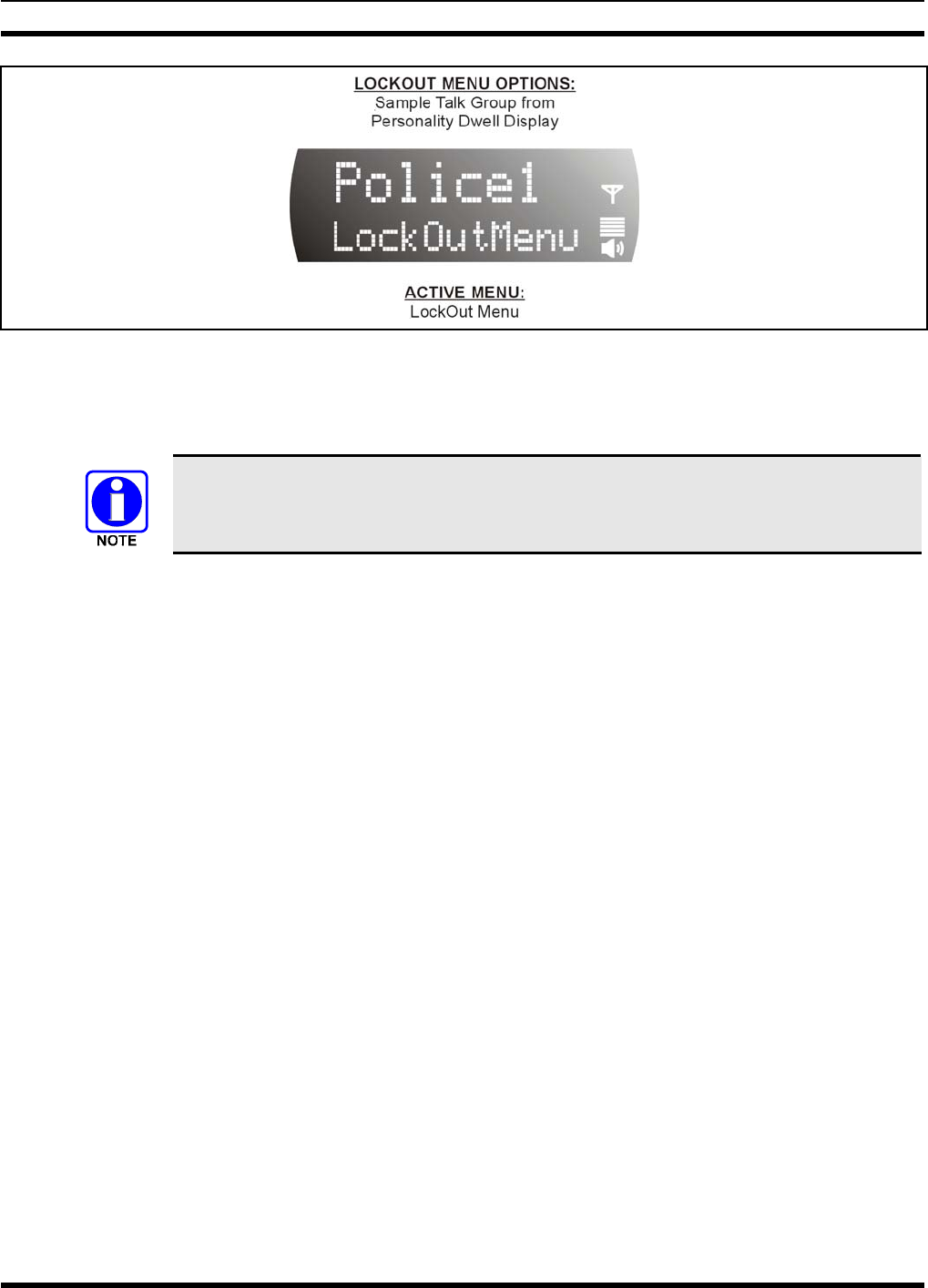
MM-011709-001
27
Figure 3-11: Lock Out Menu
3. Press the Select button to unlock the talk group. The less-than symbol (“<”) next to the name of the
talk group disappears. The dwell display appears as soon as the radio acknowledges the selection.
• Changing the active profile removes any lockouts you have made.
• Turning off the radio removes any lockouts you have made.
3.6 SCAN MODE
Two scanning modes are available, but only one can be active at any time. Changing the scanning mode
changes the way the radio scans voice calls for all profiles in the radio personality, no matter which
profile is, or becomes active.
As described in Table 3-6, the choice of scanning mode broadens or narrows the span of communications
with all the talk groups in the radio’s profiles, but does not affect interaction with the talk groups.

MM-011709-001
28
Table 3-6: Scan Modes
SCAN
MODE EXPLANATION
No Scan
Eliminates distractions.
Full communications (transmit and receive) on selected talk group.
No calls received from other talk groups.
Normal
(Default)
The user can scan all talk groups in the active profile that are not locked out as long as there
is demand on the site.
Priority (P1 and P2) groups are user selectable.
Receive calls from more than one talk group, if available from the current site.
Allows dragging of the selected talk group, P1, P2, and default emergency talk groups to the
site on which the radio is registered. (If other calls are available at the site, they also can be
heard but they will not be actively dragged.)
The default emergency talk group, as well as any emergency-enabled talk groups, is only
dragged if it is in emergency mode.
Fixed
The priority groups are fixed to the selected profile’s pre-defined P1 and P2 groups
(configured via the UAS). In this mode, P1 and P2 groups CANNOT be locked out.
The user can scan all talk groups in the active profile that are not locked out, as long as
there is demand on the site.
Allows dragging of the P1, P2, and selected talk group to the site on which the radio is
registered. If other calls are available at the site, they can also be heard, but they will not be
actively dragged.
The default emergency talk group, as well as any emergency-enabled talk groups, is only
dragged if in emergency mode.
3.6.1 Checking or Changing Active Scan Mode
The currently active scan mode does not appear in the dwell display. To check it, access “ScnModeMenu”
and observe it in the top line of the display. To change the active scan mode, access “ScnModeMenu” and
select the other mode as described in the following section.
3.6.1.1 Changing Scan Mode
1. Use the ▲ and ▼ buttons to scroll through the menus until “ScnModeMenu” appears in the display.
2. Use the ◄ or ► buttons to scroll through the scan options until the desired mode appears. See Table
3-6.
3.6.2 Scanning Priority
The following lists the scanning priority order (from highest to lowest):
• Selected talk group in emergency state
• Default emergency group in emergency state
• Selected talk group
• Emergency capable group in emergency state
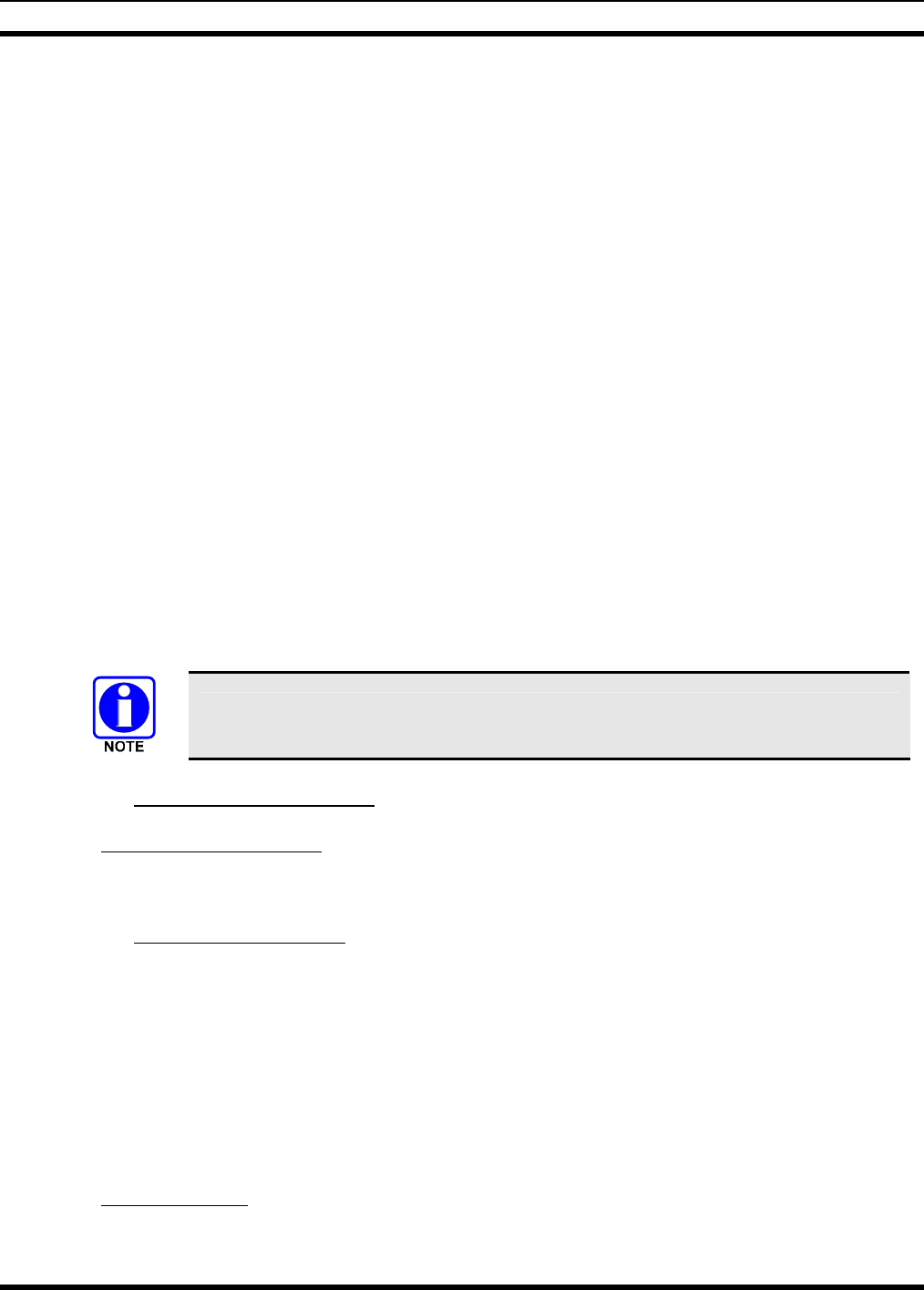
MM-011709-001
29
• Priority 1 talk group
• Priority 2 talk group
• Other (non-priority)
3.6.2.1 Set Talk Group Priority
Follow this procedure to make talk groups in the current profile the Priority 1 or Priority 2 talk group.
1. Use ▲ or ▼ to scroll through the menu until “Priority1” or “Priority2” appears in the bottom line of
the display (Priority1 group has higher priority than the Priorty2 group). The talk group currently set
as the priority talk group appears in the top line of the display.
2. Use ◄ or ► to select a new priority talk group.
3. Press the Select button to set the newly selected talk group as the priority talk group.
3.7 SELECTIVE CALL
Selective calling is a feature that allows two radio units, a CS-7200 and a mobile radio for example, to
obtain and utilize an independent voice path for a private call. Radios can be configured to both initiate
and receive selective calls or to only receive selective calls.
In the OpenSky system, a source radio can be configured to initiate selective calls through a pre-
programmed list in memory. This method uses the “speed dial list” set up by the OpenSky network
administrator and provisioned as part of the registration process.
In addition, a properly equipped source radio can initiate a selective call to any radio in the system by
entering the ten-digit voice user ID (which looks like a telephone number) of the target device.
Selective calls are terminated if an emergency is declared. The network limits selective
calls to ten (10) minutes maximum.
3.7.1 Making a Selective Call
1. If using the DTMF keypad:
A. Press *8 on the keypad.
B. Enter the number of the radio to be called (e.g., 027-001-0006). Like dialing a telephone number,
ignore/do not enter dashes. If the region number (first 3 digits; 027 in this example) is the same as
this radio’s region number, these digits do not need to be entered. Likewise, if the region and
agency numbers (first 6 digits; 027-001 in this example) are the same as this radio’s numbers,
these digits do not need to be entered. Leading zeros can also be ignored.
C. Press and release the # key.
D. Wait approximately two (2) seconds.
E. Press and release the PTT button to initiate the selective call request. When the called party
accepts the call, press the PTT again and begin speaking.
F. Selective calls are limited to a maximum duration of ten minutes.
Using Speed Dial:
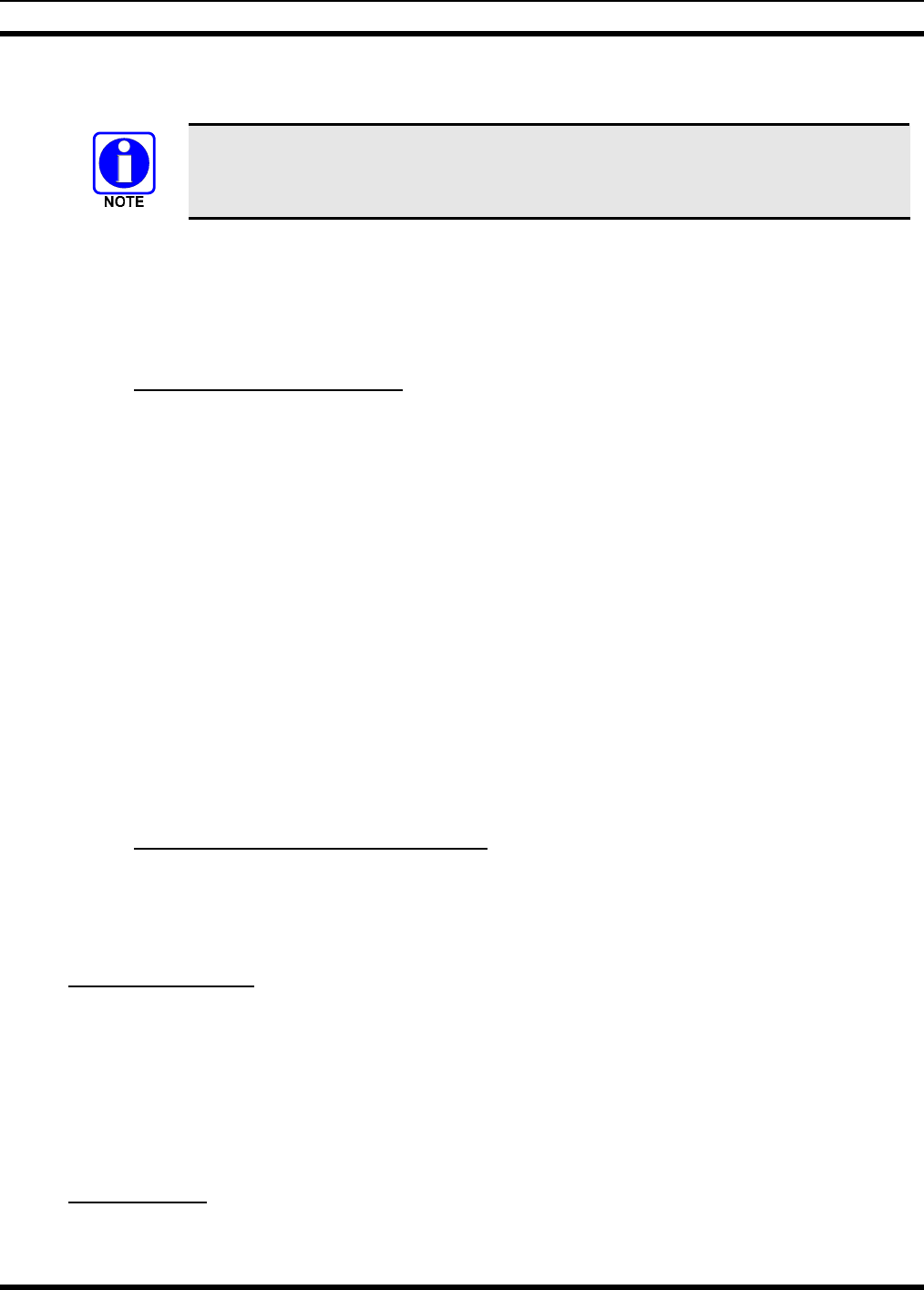
MM-011709-001
30
A. Scroll through the Menu options using the ▲ and ▼ buttons until “SpeedDial” appears in the
bottom line of the display.
Speed dial numbers are defined and provisioned by the OpenSky network
administrator and cannot be manually entered into the radio by the user. Contact the
administrator if changes to the speed dial list are required.
B. Using the ◄ and ► buttons, scroll through the pre-programmed speed-dial numbers until the
desired number appears in the display.
2. Continue by pressing the PTT button when speaking (transmitting) to the caller.
3. To end the call, press the Select button.
3.7.2 Receiving a Selective Call
When someone calls in from another radio using the selective call function a ring will sound in the
speaker and/or headset. Press the ► button to answer the call and press the microphone’s PTT button
when speaking (transmitting) to the caller. Press the Select button to end the call.
A selective call will be interrupted if an emergency is declared on a monitored talk group.
3.8 SELECTIVE ALERT
Selective alert messaging is an OTP feature allowing one of up to eight (8) pre-programmed text
messages (refer to section 3.8.3) to be sent from one radio to another. The user specifies a destination
radio’s User ID, selects one of the pre-programmed text messages, and then transmits it to the destination
radio. The message delivery system adds time-of-day information and forwards the message to the
destination (receiving) radio. The sending radio receives a brief message noting the status of the
transmission. Refer to Table 3-7 for a list of possible status messages.
The first few characters of a message are part of the message text entered when the message is
programmed. This programming is performed by the system or network administration personnel.
Messages successfully received by the destination radio are stored until deleted or until it is power cycled.
3.8.1 Sending Selective Alert Messages
3.8.1.1 Specifying the Destination
The destination radio’s User ID can be selected via the menu buttons on the radio’s front panel or via the
keypad.
Menu Button Method
1. Using the ▲ or ▼ button, scroll through the menu until “AlertDest” (Alert Destination) appears in
the bottom line of the display. The current speed dial number scrolls on the top line.
4. Press the ◄ or ► button to change to a different speed-dial number. Pause between each arrow
button depress to observe the entire number as it scrolls across the top line of the display.
5. When the desired speed-dial number appears, press the Select button to activate the selection.
6. Continue with section 3.8.1.2.
Keypad Method
To select the destination radio’s User ID using the keypad, perform the following:

MM-011709-001
31
1. Press *7 on the keypad. “AlertDest” appears in the display.
2. Enter the number of the destination radio (e.g., 027-001-0006) using the DTMF keypad. Like dialing
a telephone number, ignore/do not enter dashes. If the region number (first 3 digits; 027 in this
example) is the same as this radio’s region number, these digits do not need to be entered. Likewise,
if the region and agency numbers (first 6 digits; 027-001 in this example) are the same as this radio’s
numbers, these digits do not need to be entered. Leading zeros can also be ignored. Refer to Section
3.11.
3. Press the # key to enter the number.
3.8.1.2 Choosing and Sending the Message
After specifying the destination radio’s User ID (section 3.8.1), the radio automatically allows you to
choose a message. The current message scrolls across the top line of the display. To choose a message:
1. Scroll through the message list using the ◄ or ► button. The next available message in the list is
displayed. Pause between each arrow button depress to observe the entire message as it scrolls across
the top line of the display.
If the destination radio’s User ID was chosen via the keypad, the keypad’s 4 and 6 buttons can also be
used to scroll through the available messages.
2. To select and send the displayed message, press the Select button, or press the # button on the
keypad.
3. The status of the sent message will be momentarily displayed. Possible status Selective Alert status
messages and their meanings are listed in Table 3-7.
Table 3-7: Possible Status of Selective Alert
STATUS MESSAGE DEFINITION
Delivering Select Alert message transmit attempt
Congested Too busy – Try again
Dest Down Receiving radio not logged on – Not registered
Not Reg Transmitting radio not logged on – Not registered
Delivered Transmission complete
Unreach No response
Partial Transmission interrupted
3.8.2 Receiving Selective Alert Messages
When a selective alert message is received by a radio, a four-beep tone is heard and “NewAlert” flashes
until the new message is read. Up to eight (8) received messages are stored. If another message is
received, the first (oldest) message automatically deletes to make room for the new incoming.
3.8.2.1 Displaying Messages Received
1. Using the ▲ or ▼ button, scroll through the menu until “AlertsRecvd” (Alerts Received) appears in
the bottom line of the display. “No alerts” or the last received (newest) message appears in the
display. It is preceded by the time the message was received, and the sender’s name/alias.
2. View other received messages using the ◄ and ► buttons. Use ◄ to view older messages and ► to
view newer messages.

MM-011709-001
32
3. To delete the message currently being viewed, press the Select button.
3.8.2.2 Deleting Received Messages
To delete a received message:
1. Display the message (refer to Section 3.8.2.1).
2. Delete the message by pressing the Select button.
3. Confirm the deletion by pressing the Select button again.
3.8.3 Defining Pre-Programmed Messages
All selective alert messages are pre-defined by the radio system’s maintenance personnel. These messages
are sometimes referred to as “canned” messages. Custom selective alert messages cannot be created by
the radio user. The entire selective alert message, including the abbreviation, can include up to two
hundred (200) text characters.
3.9 TELEPHONE INTERCONNECT CALLS
If the radio system is equipped with Public Switched Telephone Network (PSTN) interconnect
equipment, telephone calls can be made using this procedure:
1. Press the *9 keys.
2. Enter the telephone number. (Ignore dashes/spaces, and precede the number with any required access
digits such as a 1 for long distance.)
3. Press the # key.
4. Wait a few seconds and then press and release the PTT button to initiate the call. An initial ring tone
plays indicating call initiation. Once the gateway picks up the call, the ring tone changes.
5. When the caller answers, depress the PTT button when speaking and release it to listen to the caller.
6. To hang-up, press the Select button on the front panel.
3.10 EMERGENCY COMMUNICATIONS
The radio can transmit both emergency voice calls and emergency alerts over the entire network.
OpenSky handles emergency calls and alerts with the highest priority.
For critical voice communications, an emergency call can be raised on the default talk group or the
currently selected talk group by “declaring” an emergency on the talk group. The exact talk group is
determined by the currently active profile. After successfully declaring an emergency on a talk group, the
declaring radio’s microphone remains “hot” for a predetermined amount of time. In other words, the radio
transmits audio for a period of time even when the PTT button is not depressed. An emergency talk group
is provided greater priority and infinite hang-time by the radio system’s infrastructure. Hang-time is the
maximum duration of quiet time between transmissions on the talk group before the infrastructure assets
are automatically taken away. Because an emergency call is handled on a talk group, it is received by all
radios and consoles monitoring the talk group.
An emergency alert is a data message sent by a radio to the MIS console (or any console capable of
receiving it). It identifies the radio declaring the emergency, and the radio’s location (if the radio is
equipped with a GPS receiver). Voice audio is not automatically transmitted during the emergency if the
administrator configures the radio for alert notification only.

MM-011709-001
33
3.10.1 Declaring an Emergency Call or Alert
To declare an emergency call or emergency alert, press and release the orange Emergency button on the
SP-103 or the function button on the Tone Remote Desk Set that has been configured as the Emergency
set button. (On the SP-103, the Emergency button is located just to the right of the 5-button Menu and
Selector keypad.)
• The OpenSky network administrator determines if the Emergency button is used to declare an
emergency call or if it is used to declare an emergency alert. This is based upon the radio’s currently
active profile.
• The OpenSky network administrator also determines if the emergency is declared on the currently
selected talk group or a “default” emergency talk group. Again, this is based upon the radio’s
currently active profile. A talk group upon which an emergency is declared on is considered an
“emergency talk group.”
• Upon successful emergency declaration:
¾ An emergency tone will sound
¾ At the declaring radio, the Emergency button flashes red. The administrator can configure the
radio to automatically transmit upon successful emergency declaration, at which point the Select
button will flash red. However, the Select button flashing red is not a requirement for successful
emergency declaration.
¾ For an emergency call declaration, “EMERGENCY” indicates in the bottom line of the display.
In addition, the emergency talk group’s name appears in the top line of the display, followed by
an asterisk (*). The emergency talk group can be forwarded across the OpenSky network for
emergency communications.
¾ For an emergency alert declaration, “EMERG ALERT” indicates in the bottom line of the
display.
¾ For an emergency call declaration, other radio users and/or dispatchers at consoles will hear the
emergency signal, a distinctive 3-tone burst. They will also hear audio from the declaring radio’s
“hot” microphone, if any.
¾ For an emergency alert declaration, only dispatchers at consoles will hear the emergency signal
and, if any, audio from the declaring radio’s “hot” microphone.
¾ For an emergency call the declaring radio’s microphone remains “hot” for a predetermined
amount of time. In other words, the radio transmits audio for a period of time even when the PTT
button is not depressed. Audio is transmitted over the emergency talk group. When the
microphone is “hot” for this initial period (typically ten seconds), simply speak into it for voice
transmission.
If an emergency declaration is not successful, the radio will periodically re-attempt until it is successful.
During this retry period, the radio will flash “EMERG PEND” on the bottom line of the display. It will
display “EMERG RETRY” for each attempt.
3.10.2 Clearing an Emergency Call or Alert
To clear an emergency, press and hold the Emergency button for at least three (3) seconds. However, this
can only be accomplished at the radio where the emergency was originally declared (the initiating radio),
by a dispatcher at a console, at a supervisory radio, or by the network administrator. When the emergency
is successfully cleared, the remove tone will sound at the initiating radio. Also, for an emergency call, the
asterisk (*) will clear from the display.
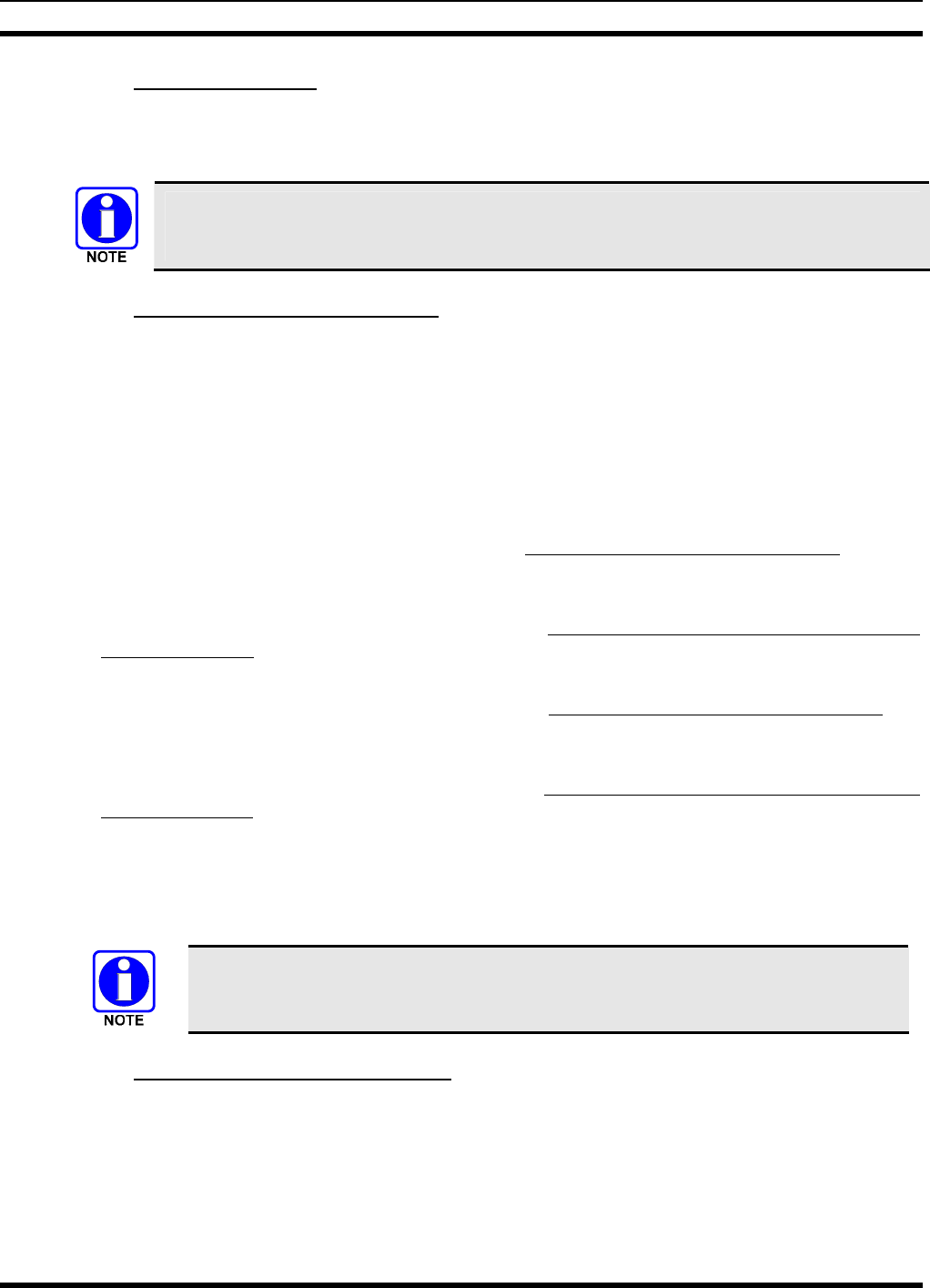
MM-011709-001
34
3.10.3 Silent Emergency
When this feature is enabled and an emergency call or alert is declared by pressing the emergency button,
the radio will not play a tone and will display an abbreviated emergency message (default is EBA). This
feature is enabled or disabled via programming or via the menu.
If the Silent Emergency feature is enabled or disabled via programming, the setting will
survive power cycle. Enable/Disable selection via the menu will NOT survive power cycle
and the enable/disable state will revert to the programmed setting at power up.
3.10.4 Receiving an Emergency Call
Upon receiving an emergency call declared by another radio:
• An emergency tone sounds in the radio’s speaker (three short high-pitched beeps).
• “EMERGENCY” flashes in the display.
• When the emergency talk group is selected, an asterisk (*) follows its name in the top line of the
display. The asterisk identifies the selected talk group is in an emergency state. Some radios may be
programmed by the system or network administration personnel to flash the Emergency button (red)
when an emergency call is received.
• If scan mode is set to “No Scan” and the emergency was declared on the selected talk group, audio on
the emergency talk group is heard in the speaker/headset. See section 3.6 for additional information
on “No Scan” operation.
• If scan mode is set to “No Scan” and the emergency was declared on a talk group other than the
selected talk group, the emergency talk group (identified by an “*”) must be selected before audio on
it is heard in the speaker/headset.
• If scan mode is set to “Normal” and the emergency was declared on the selected talk group, the
selected/emergency talk group’s name remains in the top line of the display. Audio on the emergency
talk group is heard in the speaker/headset.
• If scan mode is set to “Normal” and the emergency was declared on a talk group other than the
selected talk group, the emergency talk group’s name appears in the bottom line of the display. Audio
on the emergency talk group is heard in the speaker/headset.
• The declaring radio's alias appears in the bottom line of the display when the emergency talk group is
selected.
• An emergency call can be dismissed as described in the following section.
A radio declaring an emergency on a talk group has a “hot” mic time period of
typically ten (10) seconds just after it declares the emergency. This time period may be
adjusted by system or network administration personnel on a per radio basis.
3.10.5 Dismissing an Emergency Call
To ignore an emergency call declared by another radio user, dismiss it as follows:
1. Press the▲ or ▼ button until “EmgDismiss” appears in the display.
2. Press the ◄ or ► buttons until the talk group in the emergency state appears, as indicated by an
asterisk (*) following the talk group’s name.
3. Press the Select button.
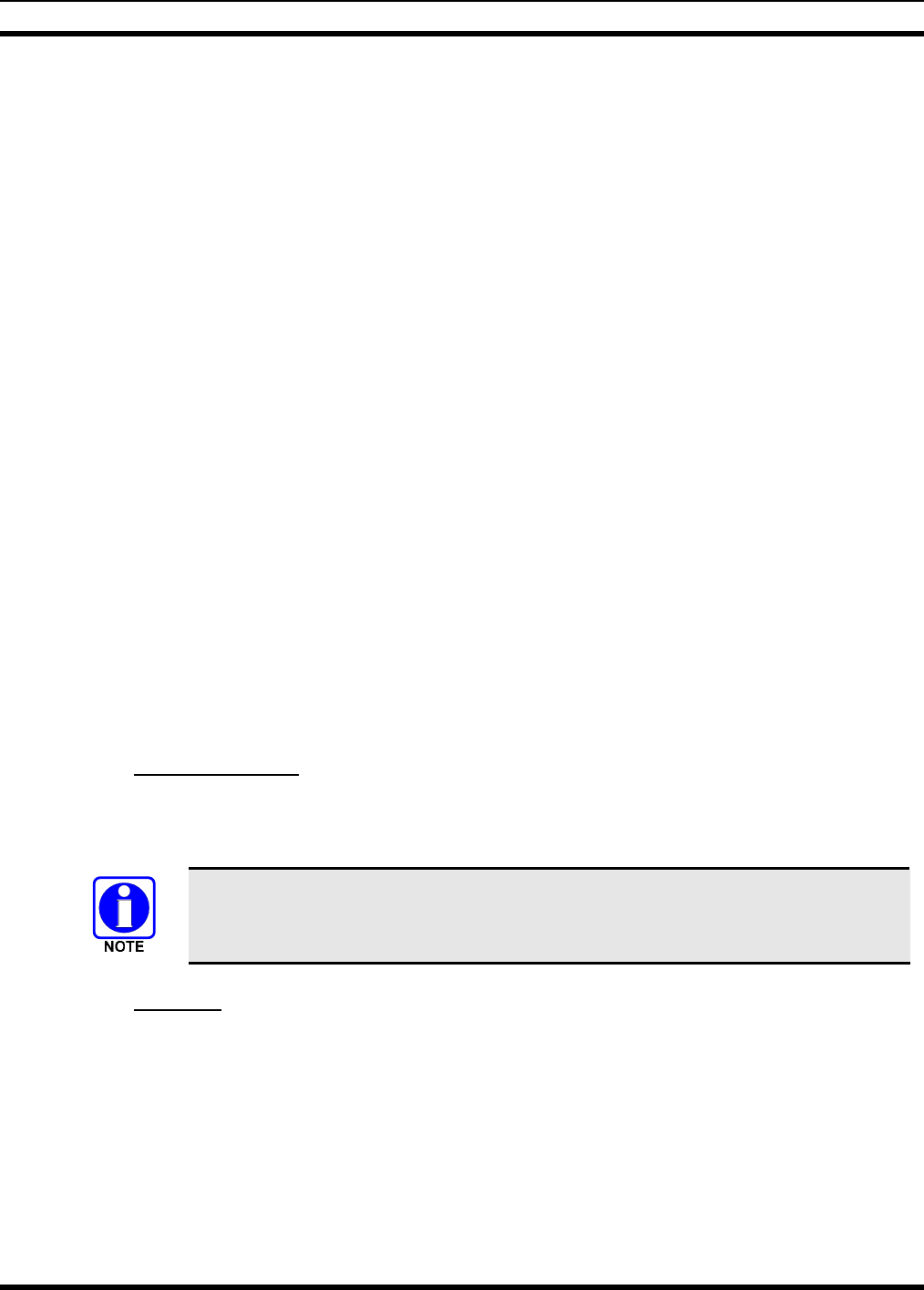
MM-011709-001
35
3.11 DUAL-TONE MULTI-FREQUENCY KEYPAD
Dual-Tone Multi-Frequency (DTMF) is the system used by touch-tone telephones. DTMF assigns a
specific tone frequency to each key so a microprocessor can easily identify its activation. This allows for
specific tasks such as entering a user ID and password, or selective calling.
When a key on the DTMF keypad is pressed, a single low-pitched tone will be heard from the
microphone. The key tones are not adjustable.
To perform a command from the keypad, press the * key followed by one of the pre-set function keys as
follows:
*0 Log-off command: *0## (logs the user off the system). See page 20 for additional information.
*1 Log-in command: *1<User ID> # <Password> ## (required for encryption). See page 20 for
additional information.
*5 Single Site Channel command: *5<SMR/NPSPAC channel>#
*6 Load Default Personality command: *6#. This command applies only if the radio is not voice-
registered on the network.
*7 Initiate Selective Alert command: *7<Target ID>#[Choose Message]#. See page 30 for
additional information.
*8 Radio-to-Radio Call command: Selective call number # (PTT to dial). See page 29 for additional
information.
*9 Public Switched Telephone Network (PSTN) Call command: See page 32 for additional
information.
*32 Begin Manual Encryption command: *32<Pre-Determined Encryption Key>#
1 – 16 digit encryption key for 128 bit encryption; 17 – 32 digit encryption key for 256 bit
encryption. See page 36 for additional information.
*33 End Manual Encryption command: *33#.
3.11.1 Password Entry
Password characters are encrypted on the display using symbols to indicate the entry. The encryption
symbols for each entry will appear in the display as they are scrolled through, for example: '-' and '+'.
Press the # key twice to complete the entry process.
If the password is wrong, the radio will not successfully register with the network for
wide area voice reception. The radio can still be used in single-site mode.
3.11.2 Overdial
In order to send DTMF tones over the radio link, hold the PTT key when pressing the DTMF keys.
3.12 ENCRYPTION
In the OpenSky network, both data and voice use a 128-bit or 256-bit key encryption standard published
by the Federal Information Processing Service (FIPS), called Advanced Encryption Standard (AES). AES
is approved by the U.S. Department of Commerce for encryption of classified materials.
When encryption is enabled on the network, data is encrypted from the MDIS to the Mobile End System
(MES). This form of encryption provides air-link security.
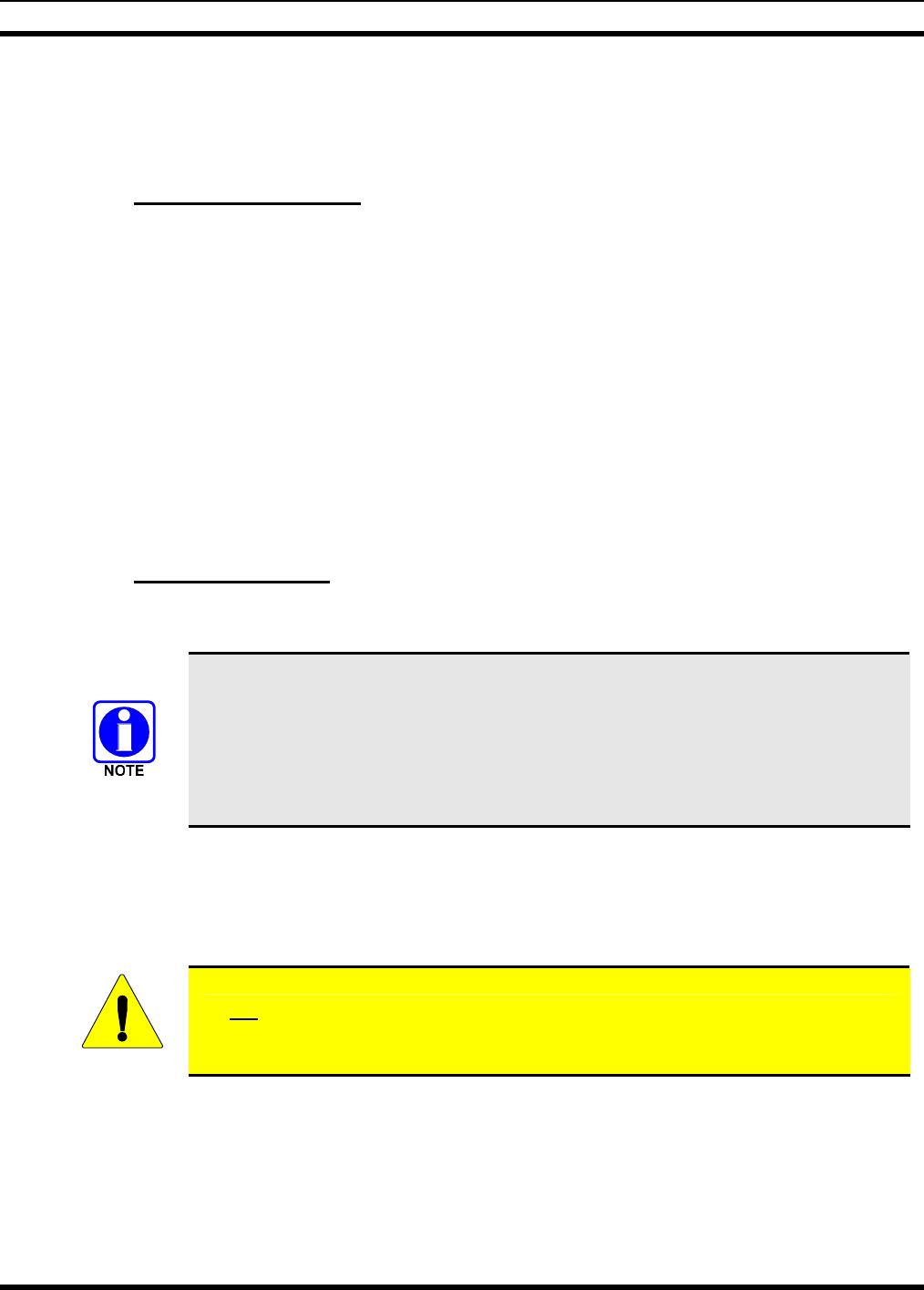
MM-011709-001
36
Voice encryption is handled either automatically or manually. Automatic encryption is initiated through
the Unified Administration System (UAS) for a specific talk group and requires nothing from the user.
Manual encryption is initiated by two or more radio users and requires DTMF keypads. Both methods of
encryption are discussed in the following sections.
3.12.1 Automatic Encryption
For automatic encryption, a network administrator will select the talk group to be encrypted at the
interface to the UAS. Once the talk groups have been selected and identified as secure, credentials for key
generation are generated automatically by the system and provisioned to authorized users. This process
requires that authorized users login to the network and be authenticated. Encryption keys require no
manual handling and are never sent “in the clear” over any network interface or air-link.
1. “Pls Login” appears displayed in the bottom line of the dwell display.
2. Login normally using the DTMF keypad to enter User ID and Password.
If a user is engaged in a call on a talk group encrypted at the network administrator level, “Secure
Call” will appear in the bottom line of the dwell display if the user is logged in to that talk group.
If a secure call is in progress elsewhere and the user has not logged in, the bottom of the dwell display
will alternate between “No Access” and the alias of the radio that is currently engaged in the secure
call.
3.12.2 Manual Encryption
Two or more users can manually encrypt a call, if enabled, without an established encrypted talk group. A
pre-determined key and a DTMF keypad are required at each radio.
The key must be pre-determined by the users prior to making a manually encrypted
call on a talk group and is entered into the radio using the keypad. For 128 bit
encryption, this key is between 1 and 16 digits. For 256 bit encryption, this key is
between 17 and 32 digits.
If two communicating radios have different (manually-defined) keys, receive audio at
each radio will sound garbled.
With manual encryption enabled, unencrypted radio users on the talk group can still make standard voice
(unencrypted) calls on the talk group. However, if an unencrypted user attempts to transmit on the talk
group when one of the encrypted users is already transmitting on the talk group, the unencrypted radio
will sound a deny tone and “No Access” will appear in the display. Also, the encrypted user can hear
standard unencrypted calls, but cannot respond while still manually encrypted.
CAUTION
Do not set a talk group for manual encryption if it has been set for encryption by
the network administration personnel.
Perform the following to transmit or receive manually encrypted calls:
1. Press *32 on the DTMF keypad.
2. Enter the key (1 – 16 digits for 128 bit encryption; 17 – 32 digits for 256 bit encryption).
3. Press the # key.
4. To end manual encryption, press *33#.

MM-011709-001
37
If a user is engaged in a call on a talk group that has been manually encrypted at the radio level, the user
will see “Secure Call” on the bottom of the dwell display.
If a secure (encrypted) call is in progress, and the user has not entered the key, the bottom of the dwell
display will alternate between “No Access” and the alias of the radio that is currently engaged in the
secure call.
Once the user has terminated manual encryption, “UnSecure” appears temporarily in the bottom line of
the dwell display.
3.13 PRESET BUTTONS
The SP-103 front panel contains three buttons labeled A, B, and C. By holding one of these buttons down
for approximately three (3) seconds, the following current information is saved to the function of that
button:
• Selected talk group
• Selected profile
• Selected priority talk group
• Lockouts
• Scan mode
• Intercom mode
When information has been saved to a preset, the button will be illuminated green. If the button is not
designated as a preset, it will be illuminated red.
Presets are saved and restored to/from non-volatile memory. Changing the User ID (login in as a different
user) will clear the presets, as they are stored on a per-user basis.
3.14 DYNAMIC REGROUPING
Dynamic regrouping requires that the network administrator determine which radio users should be
formed into an impromptu talk group to respond to particular emergency conditions.
The administrator will edit the personalities of the affected radios to include an emergency profile, and
then page the affected radios to re-register with the network to receive their edited personalities.
In response, affected radios automatically re-register to receive their edited personalities. During re-
registration, subscriber equipment will default to the emergency profile selected by the administrator.
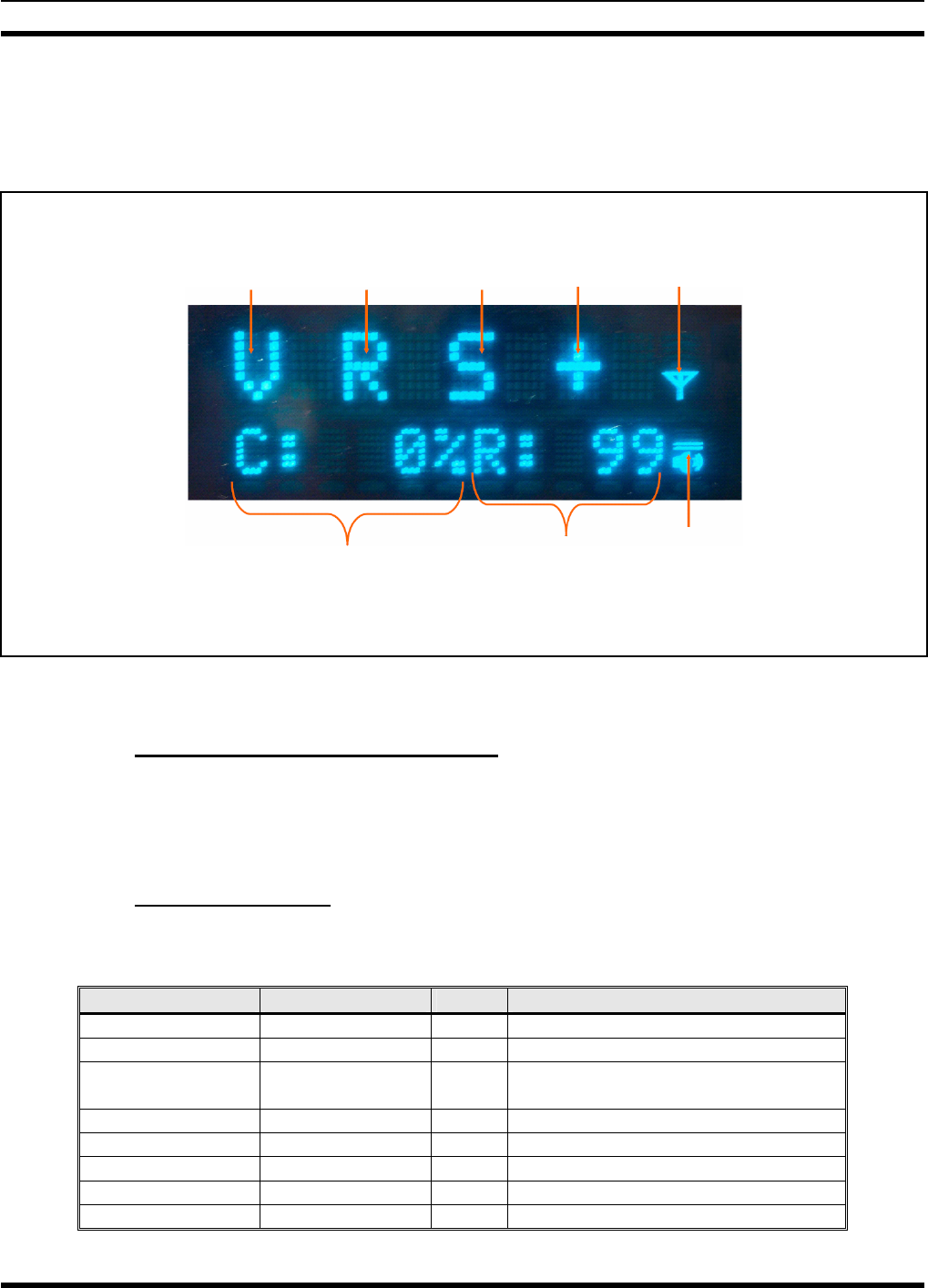
MM-011709-001
38
3.15 ENGINEERING DISPLAY
Some radios may have access to an engineering display that presents various data related to the radio
system. An example display is shown in the following figure. Typically, this display is accessed by
pressing the ▼ button once from the dwell display.
Figure 3-12: Example Engineering Display
3.15.1 Voice and Data Registration Codes
The engineering display’s voice and data registration codes identify the current registered operational
status of the radio on the OpenSky network. Voice registration is granted by the VNIC (Voice Network
Interface Controller) computer and data registration is granted by the MDIS (Mobile Data Intermediate
System) computer. See Table 3-8 and Table 3-9 respectively.
3.15.2 Transceiver Status
The engineering display’s transceiver status is a plus (“+”) symbol during normal operations.
Table 3-8: Voice Registration Codes
DISPLAYED CODE LOWER DISPLAY RETRY MEANING
(none) (none) No Off network.
a VDENIED No Voice denied: Unknown reason.
b BAD VID No
Voice denied: Unknown MES ID.
(Check User ID.)
c (none) No Voice denied: Duplicate MES ID.
d (none) No Voice denied: IP address denied.
e (none) No Voice denied: Duplicate IP address.
f BAD PWD No Voice denied: Missing password.
g BAD PWD No Voice denied: Invalid password.
Voice Registra-
tion Code
(See Table 3-8)
Data Registra-
tion Code
(See Table 3-9)
RF Synchron-
ization
(“S”=Synchro-
nized)
Transceiver
Status
(See
section
3.15.2.)
Network
Connec-
tivity Icon
Volume
Level Icon
Receive Signal
Strength
Indication
(RSSI)
(See section
3.15.3)
Control Block
Symbol Error
Rate (CBSER)
(See section
3.15.4)

MM-011709-001
39
DISPLAYED CODE LOWER DISPLAY RETRY MEANING
h HOM DWN Yes Voice denied: Home VNIC down.
i SRV BSY Yes Voice denied: Serving VNIC congested.
j (none) Yes Voice denied: Aged reg. seq. number.
k MAX USR Yes Voice denied: Too many login instances.
l UAS BSY Yes Voice denied: UAS changing talk group.
V (none) No Voice registered.
v (none) No Voice registration pending.
R (none) No Data registered only.
Table 3-9: Data Registration Codes
DISPLAYED CODE LOWER DISPLAY RETRY Meaning
R (none) No Data registered.
1 (none) No Network access denied. Unknown reason.
2 (none) No Network ID unsupported.
3 UNAUTH3 No Network ID not authorized. (Check IP.)
4 UNAUTH4 No Bad authentication.
5 UNAUTH5 No Unsupported authentication.
6 MDS BSY Yes MDIS fully loaded.
7 DUP IP No Service denied: Duplicated IP address.
p (none) No Data registration pending.
d (none) No Data deregistration pending.
3.15.3 Receive Signal Strength Indication (RSSI)
The engineering display’s RSSI number represents, in absolute value, the dBm level of the signal
received from the OpenSky’s base station transmitter. It represents a negative unit of measure, but a
negative/minus sign does not precede the number in the display. Because the displayed number represents
a negative value, higher/increasing numbers represent lower/decreasing received signal strengths.
Values lower than -110 (125 for example) indicate a possible antenna problem, or operation in a fringe or
no-coverage area.
Higher RSSI values, -85 for example (displayed 85), with CBSER values greater than zero (0) generally
indicate RF interference is being induced into the antenna system along with the received signal.
It is not uncommon for an OpenSky signal with low RSSI and degraded CBSER to be decoded by the
radio and heard at the speaker without any problem.
3.15.4 Control Block Symbol Error Rate (CBSER)
The engineering display’s CBSER value indicates data distortion or interference. Zero (0) represents no
errors. When operating in RF fringe areas, this number may increase as interference in the received data
signals increases.

MM-011709-001
40
4 CS-7200/TRCM-103 OPERATION
Ensure the TRCM-103 has been installed and calibrated in accordance with the Installation Manual.
4.1 POWER UP
1. Press the power switch on the CS-7200 rear panel. The front panel LED will illuminate.
2. Power up the Tone Remote Desk Set as directed by the third-party Desk Set user manual.
3. Wait through the startup sequence, which lasts approximately 10 seconds.
During this time, if enabled for auto registration, the radio is provisioned with a customized user
personality designed for the user’s specific needs by the Network Administrator.
4.2 NETWORK LOG ON
Network log on is either automatic or directed via a PC. Contact your local administrator for procedures
on how to log on to the network.
4.3 SELF-TEST
After power up, the CS-7200 undergoes a multi-function automatic registration procedure and self-test. It
is “provisioned” with the user personality: as many as 16 possible user profiles are downloaded to the
equipment from the network in response to the User’s ID. Emergency behavior is provisioned along with
each profile.
4.4 CONTROLS AND INDICATORS
See the third-party Desk Set’s user manual to ensure familiarity with the equipment’s Controls and
Indicators.
4.5 VOICE CALLS
As soon as the startup/log on/provision/self-test sequence and network registration is complete, voice
calls from the talk groups in the active profile will be audible, if they are available.
4.5.1 Receiving a Voice Call
No action is required to receive a voice call, since the incoming call will be forwarded as clear audio to
the third-party Tone Remote Desk Set.
4.5.2 How to Make a Voice Call
The steps for making a voice call are similar to those for a conventional radio.
1. First, ensure power is supplied to the CS-7200 (see Section 4.1).
2. Select the proper function button on the third-party Tone Remote Desk Set that corresponds to the
talk group. See your system administrator for the mapping of function buttons.
3. Depress and hold the transmit button on the third-party Tone Remote Desk Set
4. Release the transmit button when finished speaking.

MM-011709-001
41
4.6 RADIO TONES
See section 3.3.7.
4.7 POWER DOWN
Press the power switch on the CS-7200 rear panel. Saved settings will survive the power down procedure.
At the next power up, these settings will automatically default, along with network personality settings.
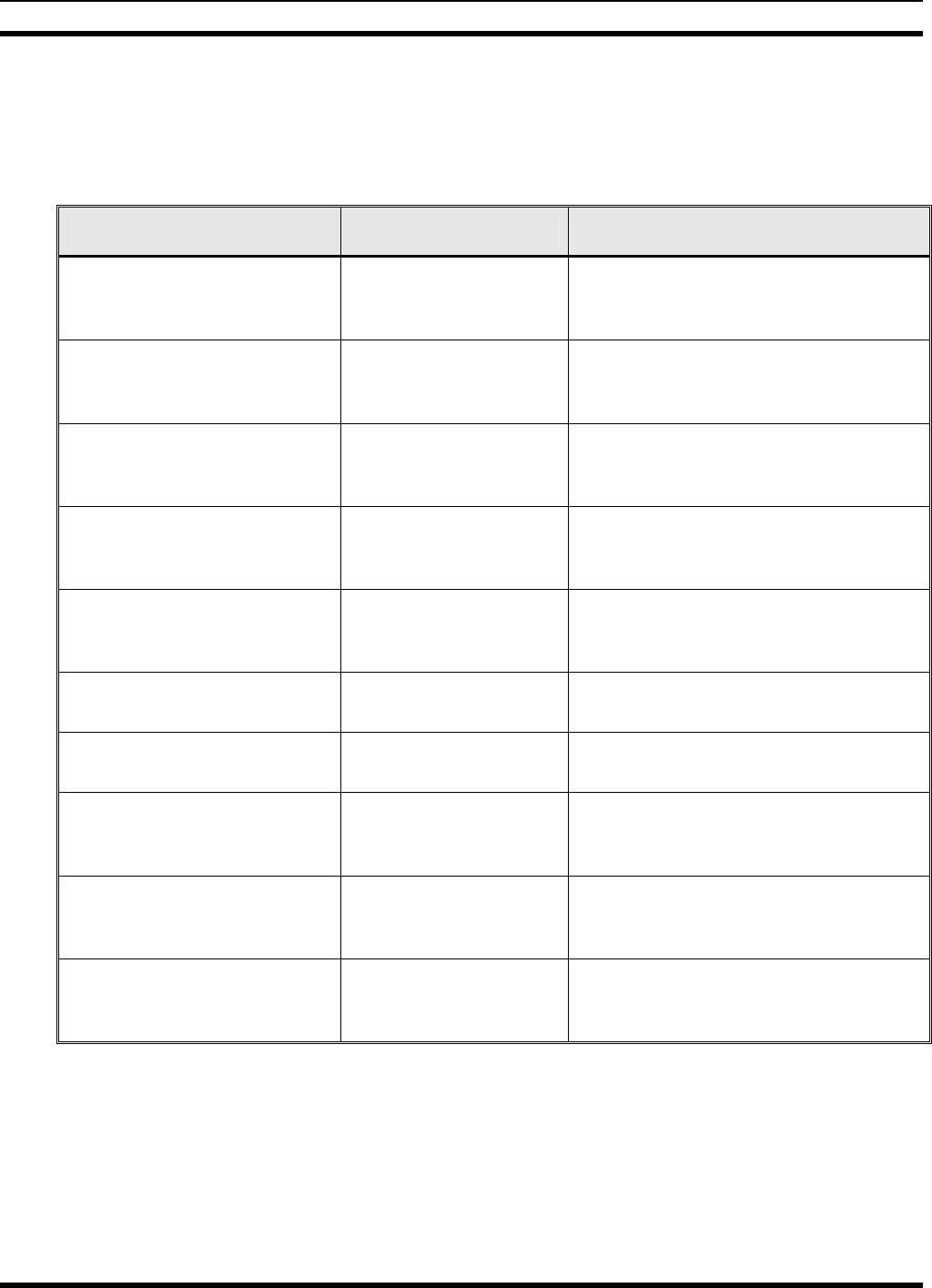
MM-011709-001
42
5 BASIC TROUBLESHOOTING
If Control Station is not operating properly, check Table 5-1 for likely causes. For additional assistance,
contact a qualified service technician.
Table 5-1: Basic Troubleshooting
SYMPTOM CAUSE SOLUTION
Station/Deskset will not turn on No power. Check connections to wall outlet and the
CS-7200/SP-103 to make sure equipment
is properly plugged in.
SP-103 Deskset displays
“No MRU” Start-up sequence may
have not completed
correctly.
Check for loose/bad CAN cable, then
power down and power up.
Start-up sequence takes longer
than 10-15 seconds. Start-up sequence may
have not completed
correctly.
Check for loose/bad CAN cable, then
power down and power up.
Station/Deskset will not turn off One of the attached SP-
103 units is still powered
up.
Power off all SP-103 units.
Station/Deskset will not register
or does not receive provisioning
data.
Bad logon credentials Check logon and password
No audio Speaker volume is
muted. Increase the volume level.
Poor SP-103 display visibility Ambient light sensor is
obstructed. Clear the obstruction and give the sensor a
clear path to ambient light.
Station/Deskset will not
transmit Station/Deskset may be
overheated. If overheated, let Station/Deskset cool
before retrying transmission. Report this
failure to an authorized technician.
Station/Deskset will not
transmit (transmit indicator on
SP-103 does not flash)
Station/Deskset may be
experiencing low
voltage.
Check connections to wall outlet and the
CS-7200/SP-103 to make sure equipment
is properly plugged in.
Equipment powers off for no
apparent reason Equipment may be
experiencing very low
voltage.
Check connections to wall outlet and the
CS-7200/SP-103 to make sure equipment
is properly plugged in.

MM-011709-001
43
6 WARRANTY
A. M/A-COM, Inc. (hereinafter "Seller") warrants to the original purchaser for use (hereinafter "Buyer") that Equipment manufactured by or for the
Seller shall be free from defects in material and workmanship, and shall conform to its published specifications. With respect to all non-M/A-COM
Equipment, Seller gives no warranty, and only the warranty, if any, given by the manufacturer shall apply. Rechargeable batteries are excluded
from this warranty but are warranted under a separate Rechargeable Battery Warranty (ECR-7048).
B. Seller’s obligations set forth in Paragraph C below shall apply only to failures to meet the above warranties occurring within the following periods of
time from date of sale to the Buyer and are conditioned on Buyer’s giving written notice to Seller within thirty (30) days of such occurrence:
1. for fuses and non-rechargeable batteries, operable on arrival only.
2. for parts and accessories (except as noted in B.1) sold by Seller’s Service Parts Operation, ninety (90) days.
3. for PANTHER™ Series handportable and mobile radios, two (2) years.
4. for all other equipment of Seller’s manufacture, one (1) year.
C. If any Equipment fails to meet the foregoing warranties, Seller shall correct the failure at its option (i) by repairing any defective or damaged part or
parts thereof, (ii) by making available at Seller’s factory any necessary repaired or replacement parts, or (iii) by replacing the failed Equipment with
equivalent new or refurbished Equipment. Any repaired or replacement part furnished hereunder shall be warranted for the remainder of the
warranty period of the Equipment in which it is installed. Where such failure cannot be corrected by Seller’s reasonable efforts, the parties will
negotiate an equitable adjustment in price. Labor to perform warranty service will be provided at no charge during the warranty period only for the
Equipment covered under Paragraph B.3 and B.4. To be eligible for no-charge labor, service must be performed at a M/A-COM factory, by an
Authorized Service Center (ASC) or other Servicer approved for these purposes either at its place of business during normal business hours, for
mobile or personal equipment, or at the Buyer’s location, for fixed location equipment. Service on fixed location equipment more than thirty (30)
miles from the Service Center or other approved Servicer’s place of business will include a charge for transportation.
D. Seller’s obligations under Paragraph C shall not apply to any Equipment, or part thereof, which (i) has been modified or otherwise altered other
than pursuant to Seller’s written instructions or written approval or, (ii) is normally consumed in operation or, (iii) has a normal life inherently
shorter than the warranty periods specified in Paragraph B, or (iv) is not properly stored, installed, used, maintained or repaired, or, (v) has been
subjected to any other kind of misuse or detrimental exposure, or has been involved in an accident.
E. The preceding paragraphs set forth the exclusive remedies for claims based upon defects in or nonconformity of the Equipment, whether the claim
is in contract, warranty, tort (including negligence), strict liability or otherwise, and however instituted. Upon the expiration of the warranty period,
all such liability shall terminate. The foregoing warranties are exclusive and in lieu of all other warranties, whether oral, written, expressed, implied
or statutory. NO IMPLIED OR STATUTORY WARRANTIES OF MERCHANTABILITY OR FITNESS FOR PARTICULAR PURPOSE SHALL
APPLY. IN NO EVENT SHALL THE SELLER BE LIABLE FOR ANY INCIDENTAL, CONSEQUENTIAL, SPECIAL, INDIRECT OR EXEMPLARY
DAMAGES.
This warranty applies only within the United States.
M/A-COM, Inc. M/A-COM, Inc
1011 Pawtucket Blvd. 221 Jefferson Ridge Parkway
Lowell, MA 01853 Lynchburg, VA 24501
1-877-OPENSKY 1-800-528-7711
ECR-7047C

M/A-COM Wireless Systems
221 Jefferson Ridge Parkway
Lynchburg, Virginia 24501
(Outside USA, 434-385-2400) Toll Free 800-528-7711
www.macom-wireless.com Printed in U.S.A.